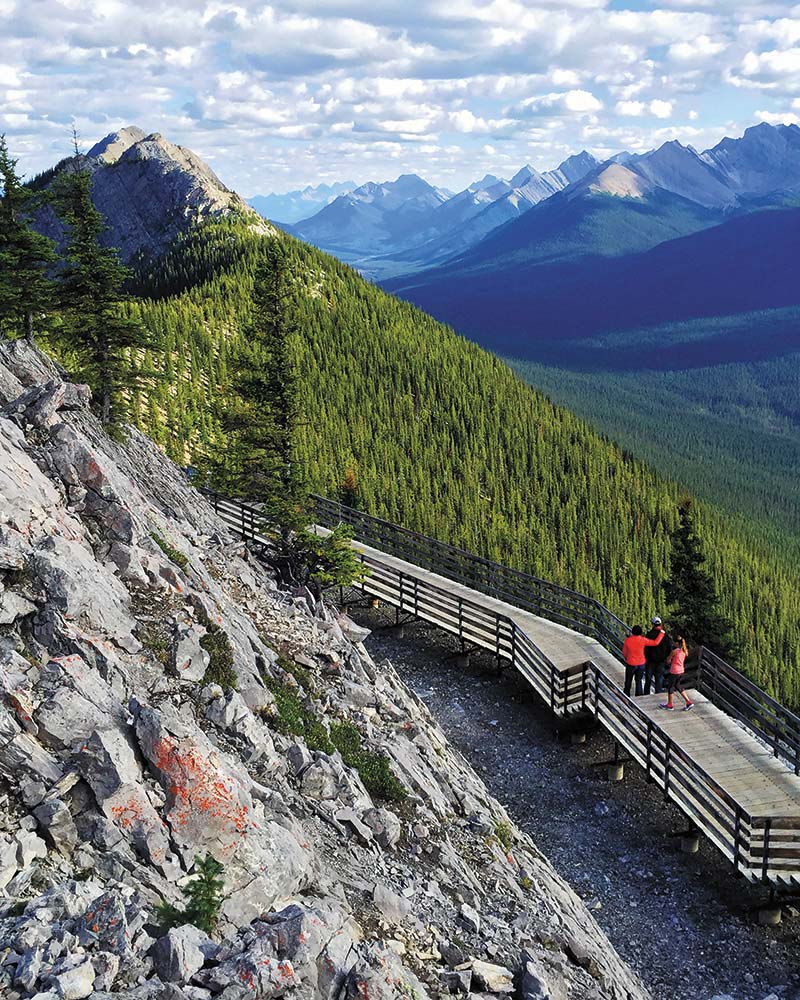
Getting to Banff and Lake Louise
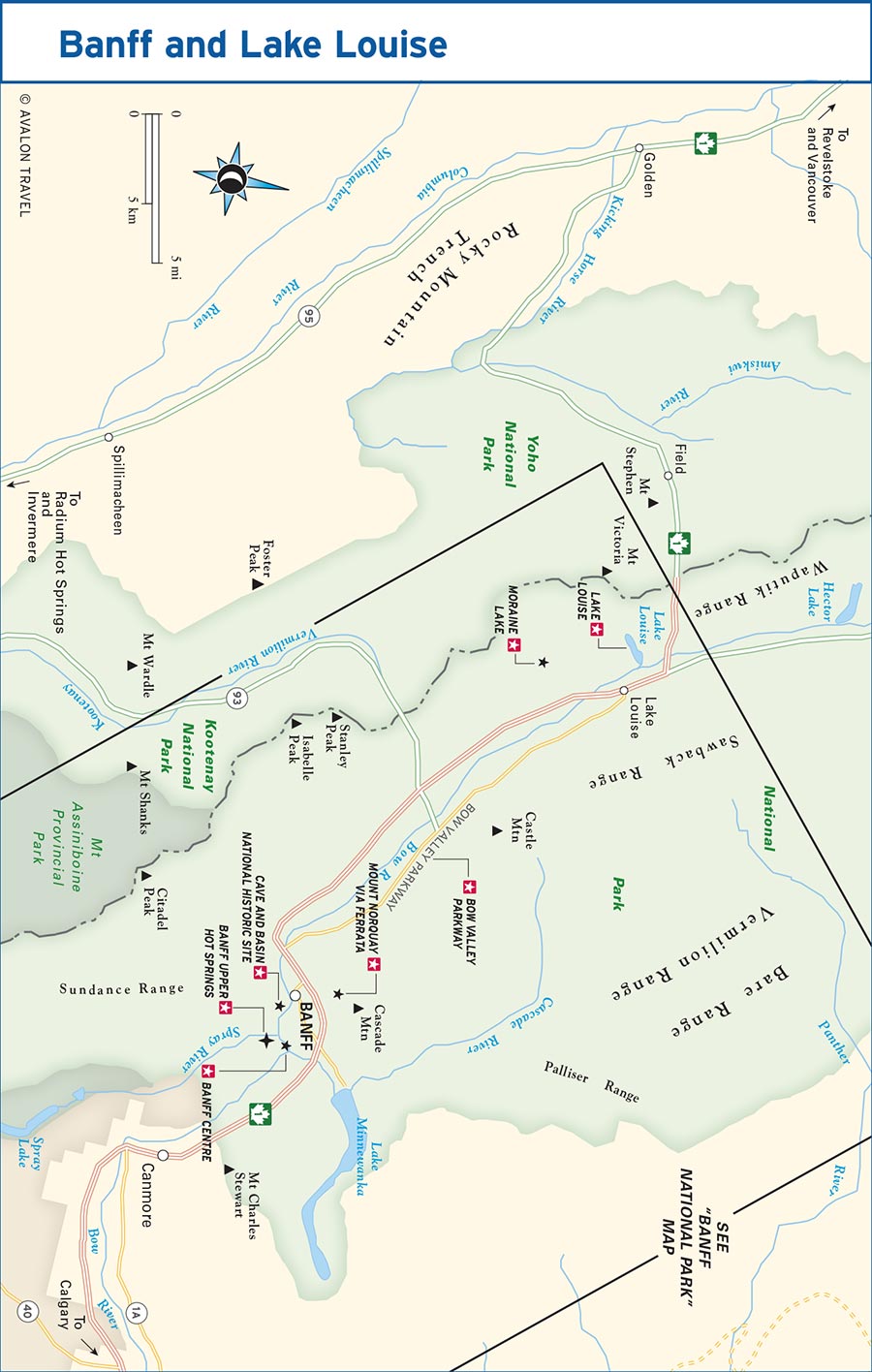
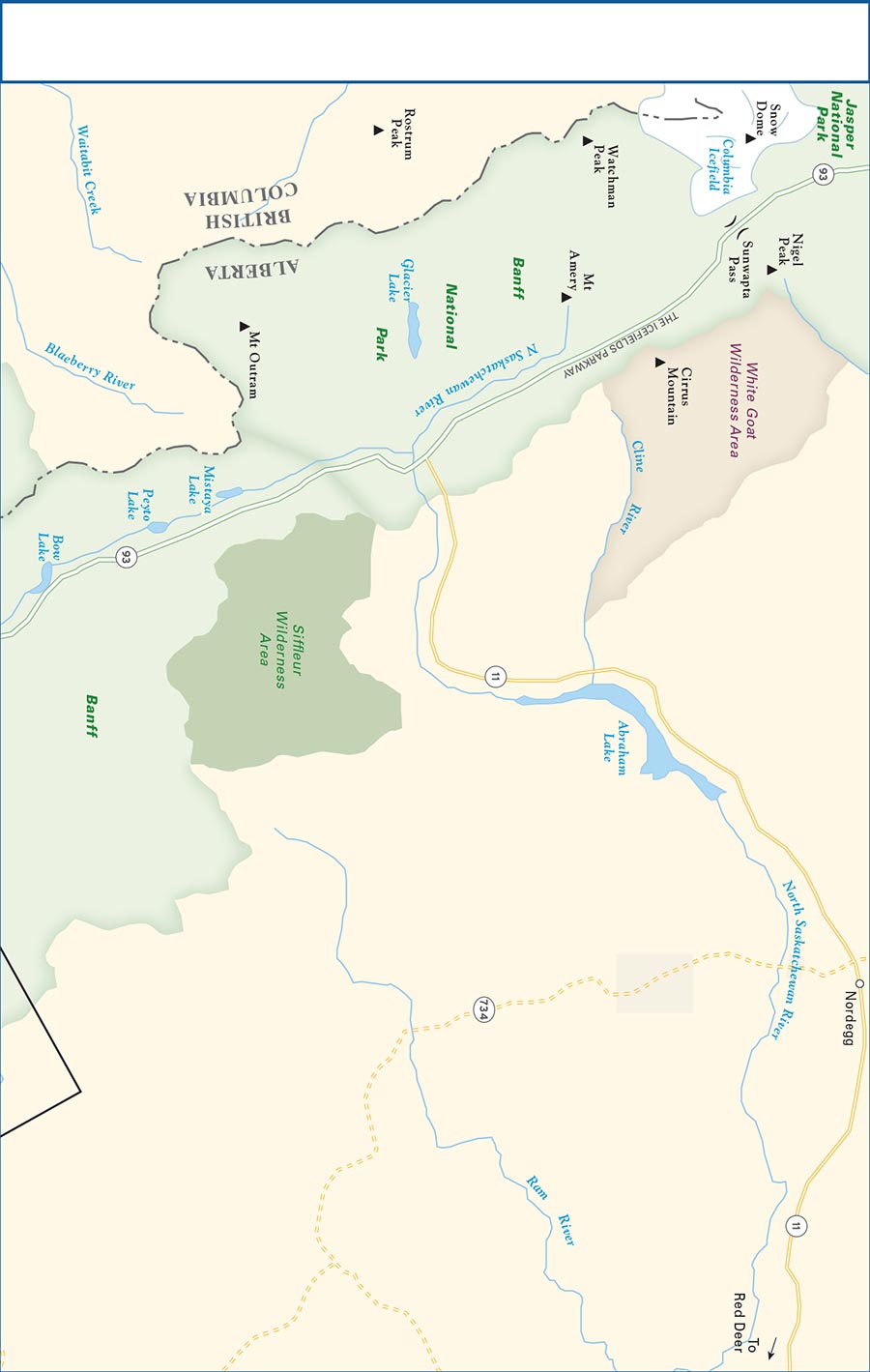
With dramatic mountain peaks, hot springs, and sparkling lakes, Banff National Park is one of western Canada’s most spectacular destinations.
An underground hot spring led to the creation of Canada’s first national park, now one of the country’s most-visited destinations; more than four million visitors every year come to soak in the mineral-rich waters, hike the more than 1,000 miles (1,600 km) of trails, drive the scenic byways lined with craggy mountain peaks, or simply enjoy the glacier-fed lakes.
Start your Rocky Mountain adventures in the town of Banff, within the national park boundaries. This town of 9,000 people has museums, gardens, historic sites, and easy access to many of the park’s hiking trails. It’s home to the Banff Centre, where plays, concerts, lectures, and other artistic events draw world-class performers and add vibrancy to this small town’s cultural life. You can eat a bison burger, fresh trout, or renowned Alberta beef, whether you dine in a classic mountain lodge, high in an alpine meadow, or around an evening campfire. Banff is even home to its own “castle in the Rockies”—the iconic Fairmont Banff Springs Hotel.
Another Canadian Rockies icon is 35 miles (57 km) northwest of the town of Banff: the impossibly beautiful Lake Louise. With sparkling blue water and glacier-capped peaks beyond, Lake Louise makes a stunning backdrop for photos. It’s a starting point for several great hikes, too, including two trails to historic mountain teahouses. You can tour Lake Louise on a day trip from Banff, ideally including a drive up the scenic Bow Valley Parkway, or escape to one of its rustic yet elegant mountain lodges or the classic lakeside hotel.
With a famous trio of peaks called the Three Sisters, the town of Canmore, 20 minutes’ drive southeast of Banff, is a quieter alternative to staying within Banff National Park. You’re close enough to make day trips to all the park sights, and the town has good restaurants and several attractions of its own, particularly for outdoor enthusiasts.
Banff National Park can be your base for exploring elsewhere in the Canadian Rockies. Both Banff and Lake Louise are close enough to Yoho National Park and Kootenay National Park that you can stay in the Banff area and make day trips to these other mountain parks. The Icefields Parkway, one of the Rockies’ best scenic drives, begins in Lake Louise and takes you north to Jasper.
The most direct route from Vancouver to the Banff area is to take the Trans-Canada Highway (Hwy. 1) east to Hope. Continue east at Hope onto Highway 3, then exit onto Highway 5 (Coquihalla Hwy.) north. Follow the Coquihalla over the mountains to Kamloops, where you rejoin Highway 1. Stay on Highway 1 past Revelstoke, Golden, and Yoho National Park into Alberta, where you’ll reach Lake Louise first and then Banff.
The drive from Vancouver to Lake Louise is 490 miles (790 km) and takes 8.5-9 hours.
To Banff, continue east from Lake Louise on Highway 1. The trip from Vancouver to Banff is 530 miles (850 km) and takes 9-9.5 hours.
From Jasper to Lake Louise, follow the scenic Icefields Parkway (Hwy. 93) south; it’s 145 miles (230 km) and takes 3.25-3.75 hours (but allow additional time for stops at the many scenic points along the way).
To Banff, continue east from Lake Louise on Highway 1.
Follow Highway 93 north through Kootenay National Park and into Alberta to the junction with Highway 1. Turn west on Highway 1 to Lake Louise; turn east for Banff. It’s 80 miles (130 km) from the town of Radium Hot Springs at the park’s southern boundary to Lake Louise, a 1.75- to 2-hour drive. From Radium to Banff, it’s 85 miles (140 km), also a 1.75- to 2-hour drive.
Follow Highway 3 west from Fernie to Highway 93 north and continue through Kootenay National Park. At Highway 1, turn west for Lake Louise or east for Banff. It’s 215 miles (345 km), a four-hour drive, between Fernie and either Banff or Lake Louise.
If you’re driving from Nelson to Banff or Lake Louise, you can choose from several different routes.
The most direct routing is to leave Nelson heading south on Highway 6. At Highway 3, turn east. When you reach Cranbrook, go north on Highway 93 and continue through Kootenay National Park. Once you cross into Alberta and reach Highway 1, turn west to Lake Louise or east to Banff. Allow about six hours for this 310-mile (500-km) drive to either Lake Louise or Banff.
For a scenic drive along the shore of Kootenay Lake, leave Nelson on Highway 3A toward Balfour, where you catch the free, 35-minute Kootenay Lake Ferry (250/229-4215, www2.gov.bc.ca, 6:30am-9:40pm daily) across the lake to Kootenay Bay. Take Highway 3A south, which winds along the lakeshore to Creston, where you can pick up Highway 3 east. Follow the directions (above) to Cranbrook, Kootenay National Park, and Lake Louise or Banff. This Kootenay Lake alternative is also 310 miles (500 km) between Nelson and either Lake Louise or Banff, but budget an extra hour (about seven hours total) for the ferry and for the slower drive along Highway 3A.
Yet another scenic option takes you from Nelson through the B.C. national parks along Highway 1 en route to Lake Louise and Banff. Leave Nelson traveling north on Highway 6 toward New Denver and Nakusp. At Nakusp, continue north on Highway 23. When you reach Galena Bay, take the free, 20-minute Upper Arrow Lake Ferry (250/265-2105, www2.gov.bc.ca, 5:30am-12:30am daily) across the lake to Shelter Bay. Continue on Highway 23 north until you meet Highway 1 at Revelstoke. Turn east onto Highway 1, which takes you through Mount Revelstoke, Glacier, and Yoho National Parks and into Alberta. This route is 295 miles (475 km), or about 6.5 hours, between Nelson and Lake Louise, and 335 miles (540 km), or seven hours, from Nelson to Banff, although you may need to allow extra time for the ferry crossing.
To travel from Kelowna, in the Okanagan Valley, to Banff, take Highway 97 north, then continue north on Highway 97A. At Sicamous, turn east onto the Trans-Canada Highway (Hwy. 1), which will take you into Alberta. It’s 300 miles (485 km) from Kelowna to Banff, which takes 5.75-6 hours.
The Trans-Canada Highway (Hwy. 1) heads west from Calgary to Banff. The 80-mile (130-km) drive takes about 90 minutes, weather and traffic permitting.
To Lake Louise, continue west from Banff on Highway 1; Calgary to Lake Louise is 115 miles (185 km), a 2.25-hour drive.
Calgary International Airport (YYC, 2000 Airport Rd. NE, 403/735-1200, www.yyc.com) is the closest airport to Banff. The airport is on Calgary’s northeast side, 90 miles (145 km) from Banff.
From the Calgary airport, you can take a scheduled shuttle directly to Banff. Both the Banff Airporter (403/762-3330 or 888/449-2901, www.banffairporter.com, one-way adults $67, seniors $61, ages 3-12 $34) and Brewster Banff Airport Express (403/762-6700 or 866/606-6700, www.banffjaspercollection.com, one-way adults $71, ages 6-15 $36) make the trip in about two hours and stop at most Banff hotels.
Brewster Banff Airport Express also runs buses from Calgary airport to Lake Louise (3.25-3.5 hours, one-way adults $98, ages 6-15 $49).
VIA Rail, Canada’s national rail carrier, does not provide service to Banff. However, the Rocky Mountaineer (877/460-3200, www.rockymountaineer.com, mid-Apr.-mid-Oct.), a privately run luxury train, does, offering rail packages between Vancouver, Lake Louise, and Banff. You can travel round-trip from Vancouver to the Canadian Rockies and back, or book a one-way journey through the Rockies starting in either Vancouver or Calgary.
You can purchase a Rocky Mountaineer holiday with rail fare and accommodations only; the company offers a two-day train trip between Vancouver and Banff. Other packages add in a variety of activities and tours. All Rocky Mountaineer trains travel during the day and stop overnight in Kamloops en route to and from the Rockies.
Rail packages start at $1,579 per person and vary by the destination, number of days of travel, and level of service and accommodations.
Brewster Banff Airport Express (403/762-6700 or 866/606-6700, www.banffjaspercollection.com), which provides bus service between Calgary airport and both Banff and Lake Louise, can also pick you up or drop you off in downtown Calgary (2.5 hours, one-way adults $71, ages 6-15 $36). Brewster buses can take you between Banff and Lake Louise (1 hour, one-way adults $33, ages 6-15 $16) year-round. The buses stop at several downtown Calgary hotels, most Banff hotels, and several locations in Lake Louise.
On-It Regional Transit (403/312-6139, www.onitregionaltransit.ca, mid-May-early Sept., one-way $10 pp) offers seasonal weekend bus service between Calgary, Canmore, and Banff. In Calgary, passengers can catch the bus downtown (1st St. SW at 8th Ave. SW, near the Hudson’s Bay department store) or at the Crowfoot C-Train station northwest of the city center. In Canmore, the bus stop is located at the corner of Benchlands Trail and Bow Valley Trail. In Banff, buses drop passengers at the Banff Heritage Train Station (327 Railway Ave.) and Banff High School (330 Banff Ave.). Note that buses returning to Calgary pick up passengers at the high school only. Check the website for up-to-date schedules.
Established in 1885, Canada’s first national park is also one of its most popular, welcoming more than four million visitors a year. Banff National Park covers an area of 2,564 square miles (6,641 sq km) and has more than 1,000 miles (1,600 km) of hiking trails. You could hike in the park for years and never repeat the same route.
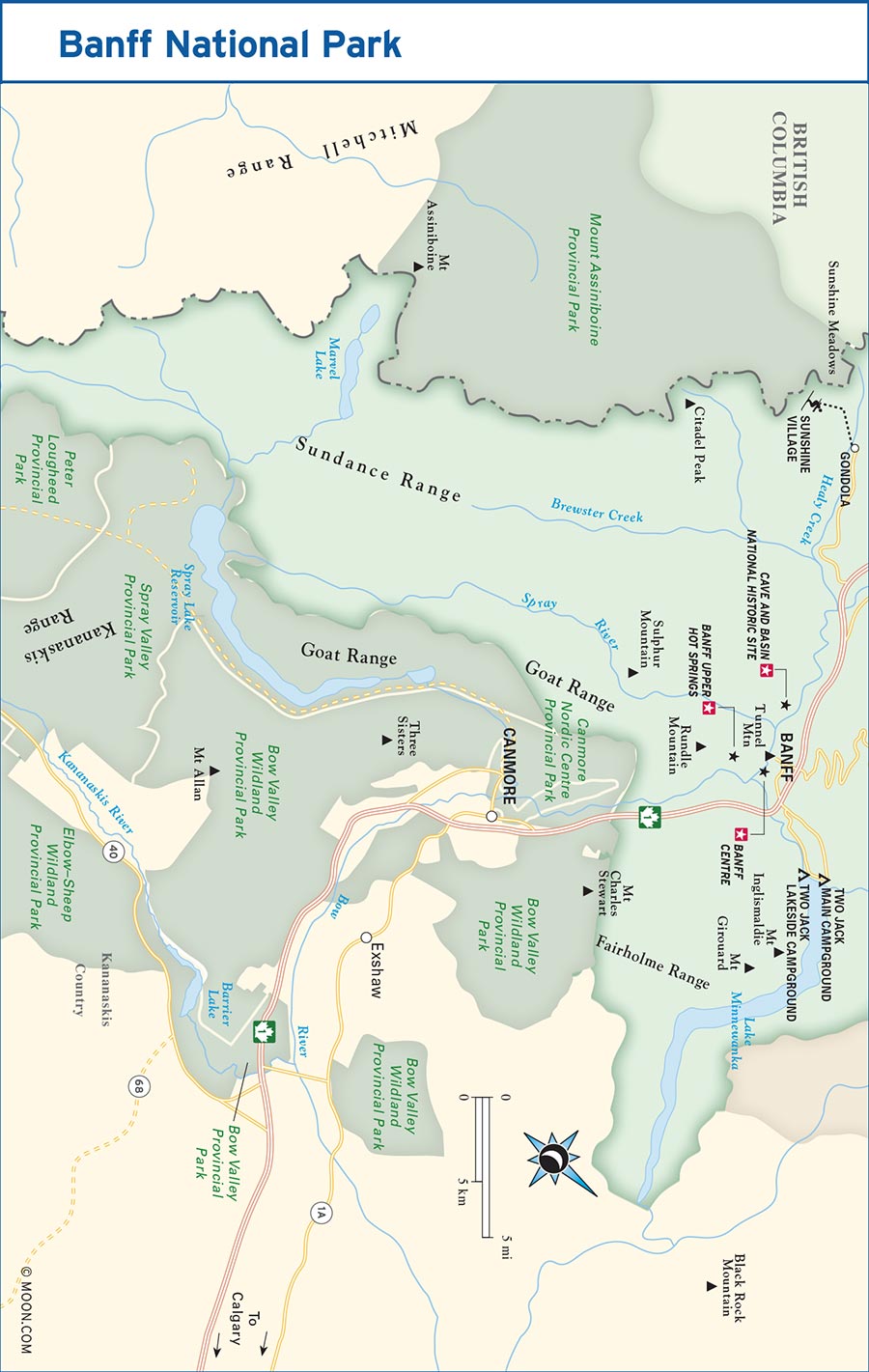
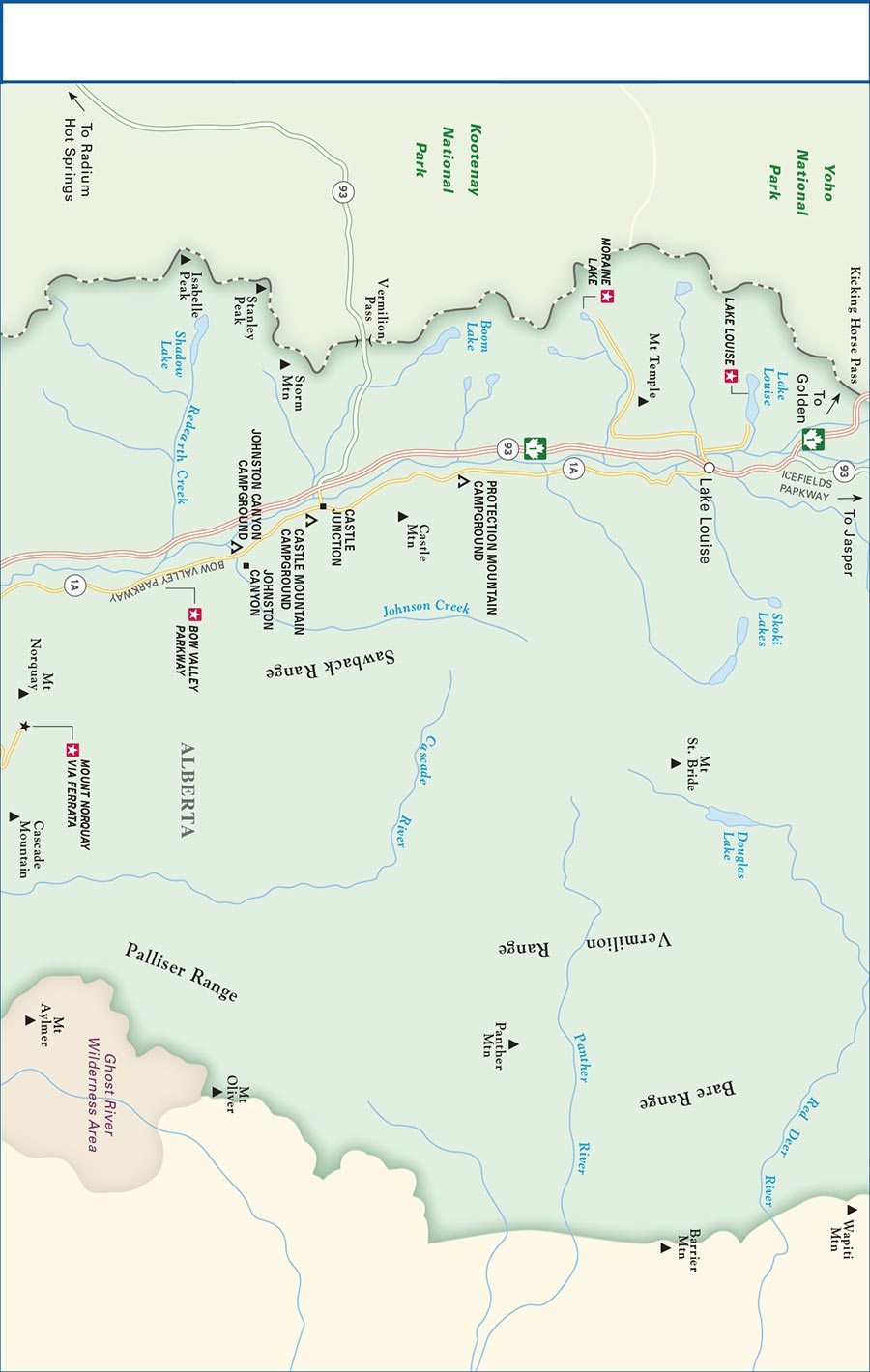
The towns of Banff and Lake Louise are both within the national park boundaries. Banff is larger, with a full complement of accommodations, restaurants, and in-town attractions, while Lake Louise is essentially a village with two famous lakes. Based in either community, though, you can easily reach most national park sites.
The Banff East Gate is on Highway 1, west of Canmore. Coming from Calgary, Canmore, or anywhere east of Banff, you must stop here and purchase a park pass, if you haven’t bought your pass in advance.
Traveling east on Highway 1 from British Columbia, you enter Banff National Park at the Alberta-B.C. provincial boundary.
If you’re driving south on the Icefields Parkway (Hwy. 93) between Jasper and Lake Louise, you enter Banff National Park along the way. The northern section of the parkway is within Jasper National Park, while the southern sector is within Banff’s boundary. You must have a valid park pass to travel anywhere on the Icefields Parkway.
TIP: Banff National Park’s web page Banff Now (www.pc.gc.ca/banffnow) lists real-time availability of parking at different areas of the park and notes any seasonal closures.
A day pass (adults $9.80, seniors $8.30, families $19.60) for Banff National Park is valid at both Banff and Jasper and for travel along the Icefields Parkway; it’s also good at Kootenay, Yoho, Mount Revelstoke, Glacier, Waterton Lakes, and Elk Island National Parks. Lake Louise is within the Banff National Park boundaries, so you must have a park pass to visit the lake area as well. A day pass is good until 4pm on the day after you purchase it. You can purchase your park pass online from Banff-Lake Louise Tourism (www.banfflakelouise.com) or at any park visitors center or entrance gate.
Purchasing a Parks Canada annual discovery pass (www.pc.gc.ca, adults $67.70, seniors $57.90, families $136.40), valid for a year, is a good deal if you’re spending at least a week in one or more parks. It’s good at more than 100 national parks and national historic sites across Canada. Buy an annual pass online from Parks Canada or at any of the parks’ visitors centers.
For both day and annual passes, the family passes cover up to seven people in a single vehicle, whether or not they’re actually related.
In the town of Banff, both Parks Canada (www.pc.gc.ca) and Banff-Lake Louise Tourism (www.banfflakelouise.com) staff the Banff Visitor Information Centre (224 Banff Ave., 403/762-8421, 8am-8pm daily mid-May-mid-Oct., 9am-5pm daily mid-Oct.-mid-May), providing information about the national park and surrounding area. You can purchase park passes and bear spray, pick up park maps, and get hiking tips here.
There’s an additional Banff Visitor Information Desk (327 Railway Ave., 8am-8pm daily mid-May-mid-Oct., 9am-5pm daily mid-Oct.-mid-May) in the Banff Heritage Train Station.
Another park visitors center is at Lake Louise. Parks Canada (www.pc.gc.ca) provides park information, sells park passes, and handles camping inquiries at the Lake Louise Visitor Information Centre (Samson Mall, 403/522-3833, 8:30am-7pm daily June-Sept., 9am-5pm daily Oct.-May), where staff from Banff-Lake Louise Tourism (www.banfflakelouise.com) assist visitors as well.
The campgrounds in Banff National Park that accept reservations include all the Tunnel Mountain Campground sites, the sites at Two Jack Lake Campground, the Johnston Canyon Campground on the Bow Valley Parkway, and the two Lake Louise campgrounds. Reservations are also accepted—and highly recommended—for the oTENTiks (platform tents) at Tunnel Mountain and Two Jack Lake.
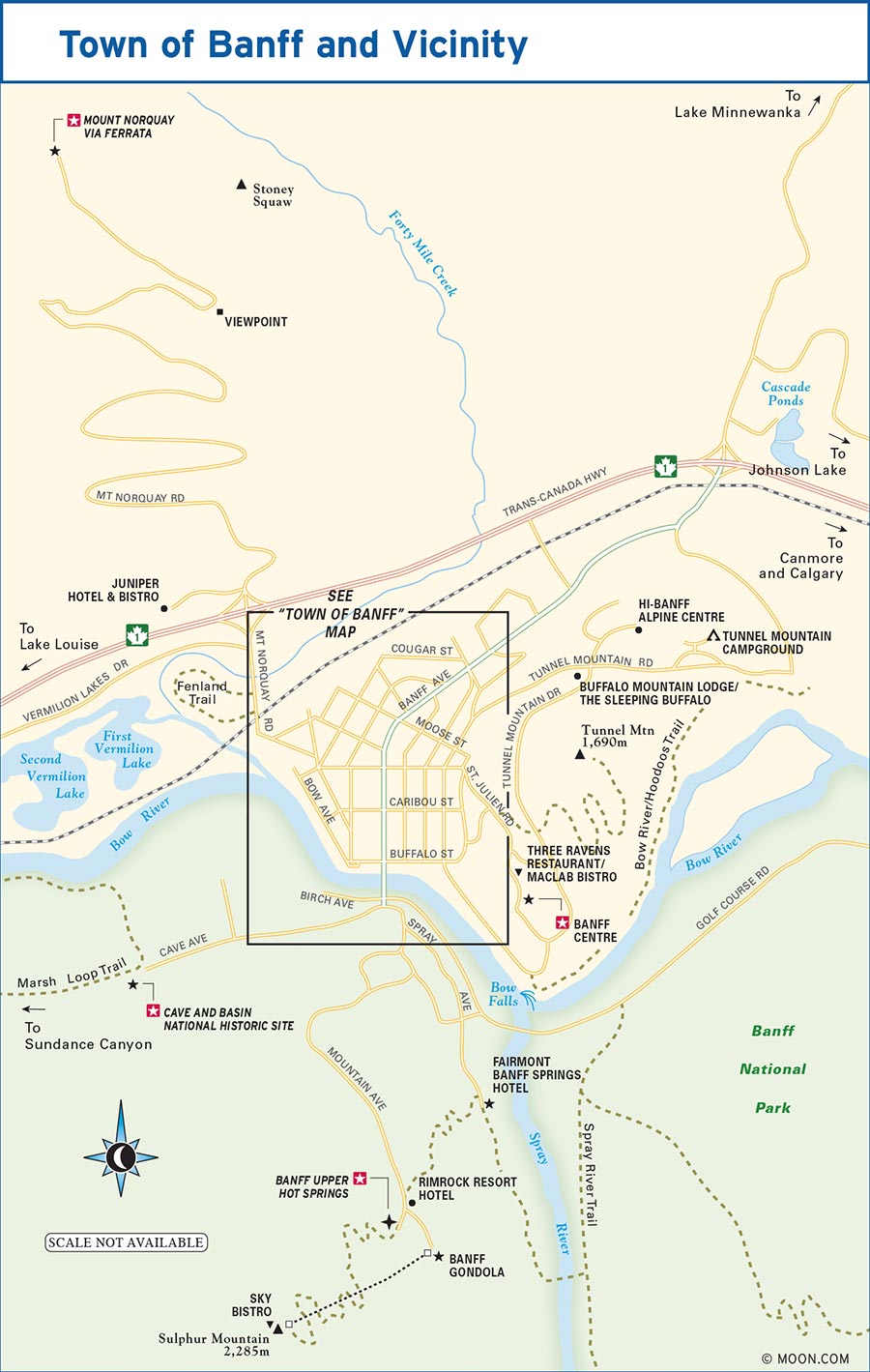
Make campsite reservations (877/737-3783, www.reservation.parkscanada.gc.ca) online or by phone as soon as possible. Reservations typically open in January for the coming year, but check the reservations site or call to confirm, so you’re ready to book as early as you can.
These sights and things to do within the park are near the town of Banff.
For a relaxing activity where you can rest your hiking feet, take a leisurely one-hour cruise on Lake Minnewanka (403/762-3473, www.banffjaspercollection.com, 11am, 1pm, 3pm, and 5pm daily early-mid May, departures on the hour 10am-6pm daily mid-May-mid-Sept., departures on the hour noon-5pm daily mid-Sept.-mid-Oct., adults $62, ages 6-15 $32), an azure glacial lake surrounded by mountain peaks. Late July-early September, there are additional cruise departures on the half hour between noon and 4pm.
The largest lake in Banff National Park, Minnewanka is 12.5 miles (20 km) long and nearly 1 mile (1.6 km) across at its widest point. Its name comes from the Stoney First Nation, who called the lake Minn-waki, or “Lake of the Spirits.” During your cruise, a guide provides commentary about the lake, the wildlife in the vicinity, and how the remains of a town lie underneath the lake’s waters. The boats are covered, so you’re protected from the sun or other inclement weather. Book your cruise online 48 hours in advance for a 10 percent discount.
The easy 1.9-mile (3-km) round-trip Stewart Canyon Trail starts near the lake and takes you to a bridge across Stewart Canyon, where the Cascade River flows into Lake Minnewanka.
The Aylmer Lookout Trail follows Lake Minnewanka’s western shore for 5 miles (8 km) before climbing steadily up 2.4 miles (3.8 km) to a former fire lookout with views back to the lake and across the mountains. Parks Canada rates this trail, which has an elevation gain of 1,837 feet (560 m), as difficult. Round-trip, the full distance is 14.7 miles (23.6 km).
Lake Minnewanka is 6 miles (10 km) northeast of the town of Banff. Follow Banff Avenue or the Trans-Canada Highway east to Lake Minnewanka Road.
You can take a scenic route back to town by continuing along Lake Minnewanka Road as it hugs the lakeshore and passes Two Jack Lake before circling back to its starting point.
Spring-fall, Roam Transit Route 6: Lake Minnewanka bus (www.roamtransit.com, 8am-8:50pm daily mid-May-mid-Sept., one-way adults $2, seniors and ages 6-18 $1, day pass $5) runs between town and the lake.
Follow Vermillion Lakes Drive for a short scenic drive or bicycle ride close to town, which takes you past a series of lakes, with 9,675-foot (2,949-m) Mount Rundle in the distance beyond.
For cyclists, the 2.7-mile (4.3-km) Vermillion Lakes Drive is part of the Banff Legacy Trail, which runs through town and connects the Bow Valley Parkway with the town of Canmore.
Vermillion Lakes Drive is about five minutes’ drive west of town. Follow Mount Norquay Road and turn left just before Highway 1.
The modern-day ski era came early to Banff. Mount Norquay (2 Mt. Norquay Rd., 403/762-4421 or 844/667-7829, www.banffnorquay.com), the first ski resort in the Canadian Rockies, opened in 1926 and installed its first mechanized rope tow in 1938, and by 1948, it had a chairlift, too. These days, the mountain has things to do in both summer and winter.
A 10-minute ride on the Sightseeing Chairlift (9am-7pm daily mid-June-mid-Sept., 10am-6pm daily mid-Sept.-mid-Oct., adults $35, ages 6-15 $24) takes you up to a viewing platform with vistas across the town of Banff, the Bow River Valley, and the surrounding peaks.
At the top of the lift, you can have lunch with a view at the Cliffhouse Bistro (11am-6:30pm daily mid-June-mid-Sept., 11am-5:30pm daily mid-Sept.-mid-Oct., $16-18), built as a teahouse in the 1950s. These days, you can choose from meal-size salads, cheese and charcuterie platters, paninis, and bao-style sandwiches.
A more adventurous way to explore the views and trails on Mount Norquay is to arrange a guided climb on the Mount Norquay Via Ferrata (daily mid-June-mid-Oct.). Designed to enable people with no rock-climbing experience to ascend a mountain climbing trail, Via Ferrata comes from the Italian for “iron way.” Iron rungs and a system of fixed cables that you clip onto along the route assist in your ascent and descent. Your guide provides an orientation before you start and can talk you through the route’s tougher sections. It’s a good workout, though it’s not the best activity for people who are afraid of heights.
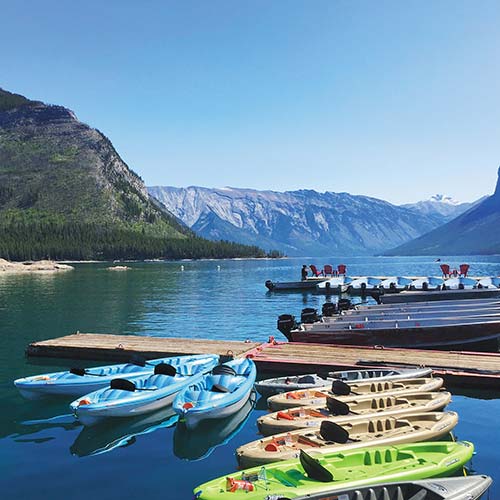
Lake Minnewanka
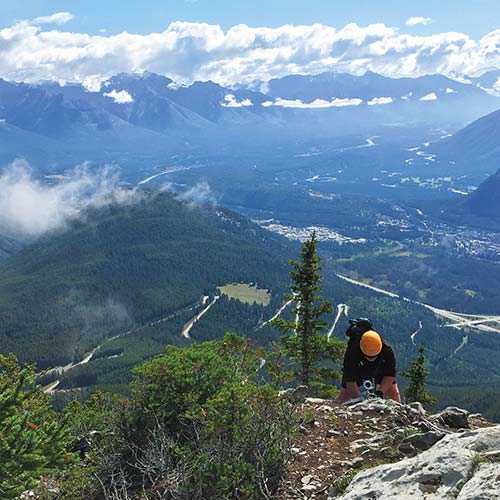
climbing the Mount Norquay Via Ferrata
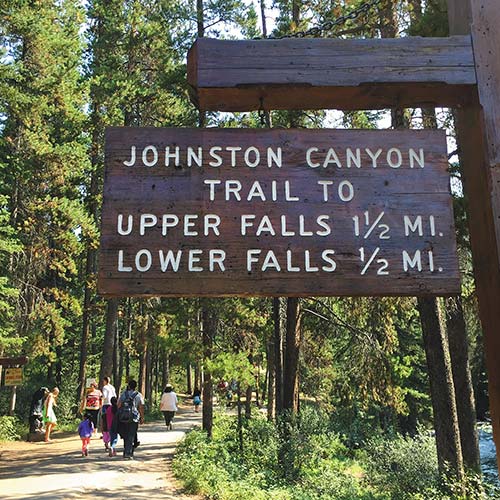
Johnston Canyon hiking trails
Mount Norquay has four Via Ferrata routes. All include the Sightseeing Chairlift and finish at the top of the lift, where you can return to the base or have lunch or a snack at the Cliffhouse Bistro. All routes take you across at least one narrow suspension bridge high above a canyon. Dress in layers; it can be much cooler on the mountain than in town, but you’ll get warm as you climb. Bring water, too.
For an introduction to the Via Ferrata, take the 2.5-hour Explorer Route (9am and 3:30pm daily mid-June-mid-Sept., 10am and 3:30pm daily mid-Sept.-mid-Oct., $149), which has plenty of challenges, but this shorter route doesn’t take you all the way to the top of the ridge.
The 4-hour Ridgewalker Route (8:30am, 10am, 1pm, and 2:30pm daily mid-June-mid-Sept., 10am, 1pm, and 2:30pm daily mid-Sept.-mid-Oct., $199) climbs up to spectacular views at the top of the Norquay ridge. This half-day excursion has a longer and steeper downhill section than the Explorer Route.
The newest of the four options, the 5-hour Skyline Route (9:30am daily mid-June-mid-Sept., 10:30am Sat.-Sun. mid-Sept.-mid-Oct., $249) adds a high traverse on a sheer rock wall and crosses a 180-foot (55-m) suspension bridge.
The 6-hour Summiteer Route (9am daily mid-June-mid-Sept., 10am Sat.-Sun. mid-Sept.-mid-Oct., $299) extends the Skyline Route with an additional traverse along the alpine ridge to Mount Norquay’s 8,038-foot (2,450-m) East Summit. You also cross a three-wire suspension bridge (imagine a tightrope with two guide wires) over a deep chasm. This tour includes lunch and après-climb refreshments at the Cliffhouse Bistro.
In winter, compact, family-friendly Mount Norquay (9am-4pm daily Nov. and Mar.-Apr., 9am-4pm Sat.-Thurs., 9am-4pm and 5pm-9pm Fri. Dec., 9am-4pm and 5pm-9pm Fri.-Sat. Jan.-Feb., adults $89, seniors and ages 13-17 $68, ages 6-12 $35) has 74 runs spread over 190 acres (77 ha) for skiing and snowboarding, including night skiing. The terrain is rated 20 percent beginner, 36 percent intermediate, 28 percent advanced, and 16 percent expert. There’s also a tube park (10am-4pm daily Nov. and Mar.-Apr., 10am-4pm Sat.-Thurs., 10am-4pm and 5pm-9pm Fri. Dec., 10am-4pm Sun.-Thurs., 10am-4pm and 5pm-9pm Fri.-Sat. Jan.-Feb., adults $35, seniors and ages 13-17 $30, ages 4-12 $25).
From town, take Lynx Street to Mount Norquay Road, which will cross over Highway 1 and climb up the mountain to the ski area. It’s a 15-minute drive.
In the summer, the Banff-Mount Norquay shuttle (7:55am-8:20pm daily June-Sept., free) can take you between downtown Banff hotels and the mountain, running about once an hour in each direction. See the Norquay website (www.banffnorquay.com) for schedules.
During the winter ski season, the Banff Ski Shuttle (daily Nov.-Apr., free) has three morning pickups in town and returns several times throughout the afternoon. Get schedules and details on the Norquay website (www.banffnorquay.com).
The most direct route between Banff and Lake Louise is the Trans-Canada Highway (Hwy. 1), but a prettier alternative is the Bow Valley Parkway (Hwy. 1A), a 30-mile (48-km) secondary route. If you drove straight through, the Bow Valley route would add about 15 minutes of travel time. In fact, because you’ll likely make numerous stops for hiking, picnicking, or simply enjoying the mountain views, plan on far more than 15 minutes extra for this scenic drive.
You must have a valid national park pass to travel on the Bow Valley Parkway, whether or not you plan to stop en route.
To protect wildlife in the area, Parks Canada restricts travel on the parkway in the spring (Mar.-late June); check the website (www.pc.gc.ca) for details on road closures.
Thirteen miles (21 km) west of Banff, Johnston Canyon is the most popular stop on the Bow Valley Parkway. Though it can be packed with walkers, the trail through the woods and along the cantilevered walkways through this rock canyon rates among the park’s most dramatic scenic stops. Come early in the morning for fewer crowds.
The busiest path is the Johnston Canyon Lower Falls Trail, a 1.5-mile (2.4-km) round-trip walk along a gentle path and several catwalks to the first set of waterfalls.
Continue past the Lower Falls on the Johnston Canyon Upper Falls Trail, which is slightly steeper, with an elevation gain of 394 feet (120 m). It’s 3 miles (4.8 km) round-trip from the parking lot to the Upper Falls, which is nearly 100 feet (30 m) high.
If you have more time, you can keep hiking beyond the Upper Falls on the Ink Pots Trail, which leads to a series of brightly colored pools. This moderate trail, with an elevation gain of 705 feet (215 m), is 6.7 miles (10.8 km) round-trip from the parking area.
Spring-fall, Parks Canada operates shuttle buses (www.pc.gc.ca, 7:45am-7pm daily mid-May-mid-Oct., round-trip adults $5, under age 18 free) between Banff Heritage Train Station (327 Railway Ave.) and Johnston Canyon, a good way to avoid the growing traffic congestion in the canyon area. The ride takes 45 minutes.
Highway 93, which travels south into Kootenay National Park, meets Highway 1 and the Bow Valley Parkway at Castle Junction, 19 miles (31 km) west of Banff. Nearby, you can spot the spiky limestone and granite cliffs of 9,076-foot (2,766-m) Castle Mountain.
A challenging full-day hike with a long steady climb takes you behind Castle Mountain to Rockbound Lake. With an elevation gain of 2,493 feet (760 m), this trail is 10.4 miles (16.8 km) round-trip. The trailhead is on the east side of Castle Junction.
The Castle Lookout was once a fire tower where fire spotters watched for blazes in the national park. Though the tower is gone, this 4.6-mile (7.4-km) round-trip hike with an elevation gain of 1,706 feet (520 m) leads up to a lookout point with views across the Bow Valley. The trailhead is 3 miles (5 km) west of Castle Junction.
Storm Mountain, 10,310 feet (3,155 m) tall, gets its name from its dramatic rain and snowstorms. You can see the mountain, along with several nearby peaks, from a pullout along the Bow Valley Parkway, west of Castle Junction. It’s a pretty spot for photos or a picnic.
From 1915 to 1917, during World War I, Castle Mountain Internment Camp housed immigrants of Ukrainian, Austrian, Hungarian, and German descent who were considered enemy aliens. Though the camp is gone, you can pull off the parkway at a memorial plaque, with information about this and other wartime camps in Canada.
Banff National Park campsite reservations (877/737-3783, www.reservation.parkscanada.gc.ca) are accepted online or by phone for all the Tunnel Mountain, Two Jack Lake, and Johnston Canyon campsites, and they’re highly recommended, especially if you’ll be traveling June-September. The other areas are first-come, first-served. Only Tunnel Mountain has electrical service and RV hookups.
Close to town, Tunnel Mountain Campground (Tunnel Mountain Rd., tent sites $27.40, electrical sites $32.30-38.20) is the largest camping area in Banff National Park. It’s divided into three sections: Tunnel Mountain Village I (mid-May-mid-Sept.) with 618 sites; Tunnel Mountain Village II (year-round) with 188 sites as well as 21 oTENTiks ($120), platform tents that can sleep up to six; and Tunnel Mountain Trailer Court (mid-May-early Oct.), which has 321 sites exclusively for trailers and large RVs up to 50 feet (15 m). All the Tunnel Mountain areas have washrooms with flush toilets and showers.
Near Lake Minnewanka, 7.5 miles (12 km) northeast of the town of Banff, Two Jack Lake Campground (Lake Minnewanka Loop Rd.) accommodates tents and small RVs in two different areas: Main and Lakeside.
Located a five-minute drive from Two Jack Lake, Two Jack Lake Main (late June-early Sept., $21.50) has 380 sites. The restrooms have flush toilets but no showers. If you don’t have your own camping gear, consider one of the 32 equipped camping sites ($70) at Two Jack Lake Main, which come with a six-person tent, sleeping pads, a stove, and a lantern. You still need to bring sleeping bags or bedding, cooking supplies, food, flashlights, and other personal items.
Many camping spots are right on the lake at the 64-site Two Jack Lake Lakeside (mid-May-early Oct., $27.40), which includes 23 walk-in tent sites. This area has flush toilets and showers, as well as 10 oTENTiks ($120). These canvas-walled platform tents sleep up to six, with one double and two queen beds, heat, and electricity, as well as an outdoor barbecue and fire pit. You need to bring your own sleeping bags or bedding, as well as food, dishes, and cooking supplies.
Bactrax (225 Bear St., Banff, 403/762-8177, www.campingbanff.com, 8am-8pm daily) rents camping gear if you don’t have your own.
Three of the national park campgrounds are along the Bow Valley Parkway (Hwy. 1A) between Banff and Lake Louise.
Opposite the Johnston Canyon trailhead, 14 miles (22 km) from the town of Banff, Johnston Canyon Campground (Bow Valley Parkway, late May-late Sept., $27.40) has 132 sites for tents and small RVs. The campground has restrooms with flush toilets and hot showers.
The 43-site Castle Mountain Campground (Bow Valley Parkway, late May-mid-Sept., $21.50) accommodates tents and small RVs; there are flush toilets but no shower facilities. It’s 21 miles (34 km) from Banff and 17 miles (28 km) from Lake Louise.
Small Protection Mountain Campground (Bow Valley Parkway, late June-early Sept., $21.50), 11 miles (18 km) from Lake Louise, has just 14 sites. The restrooms have flush toilets but no showers.
On an August afternoon in the town of Banff, which has a population of just under 9,000, pedestrians stroll the sidewalks shoulder-to-shoulder, stopping for snacks or browsing the shops. Located entirely within the boundaries of Banff National Park, the town of Banff is the park’s bustling heart.
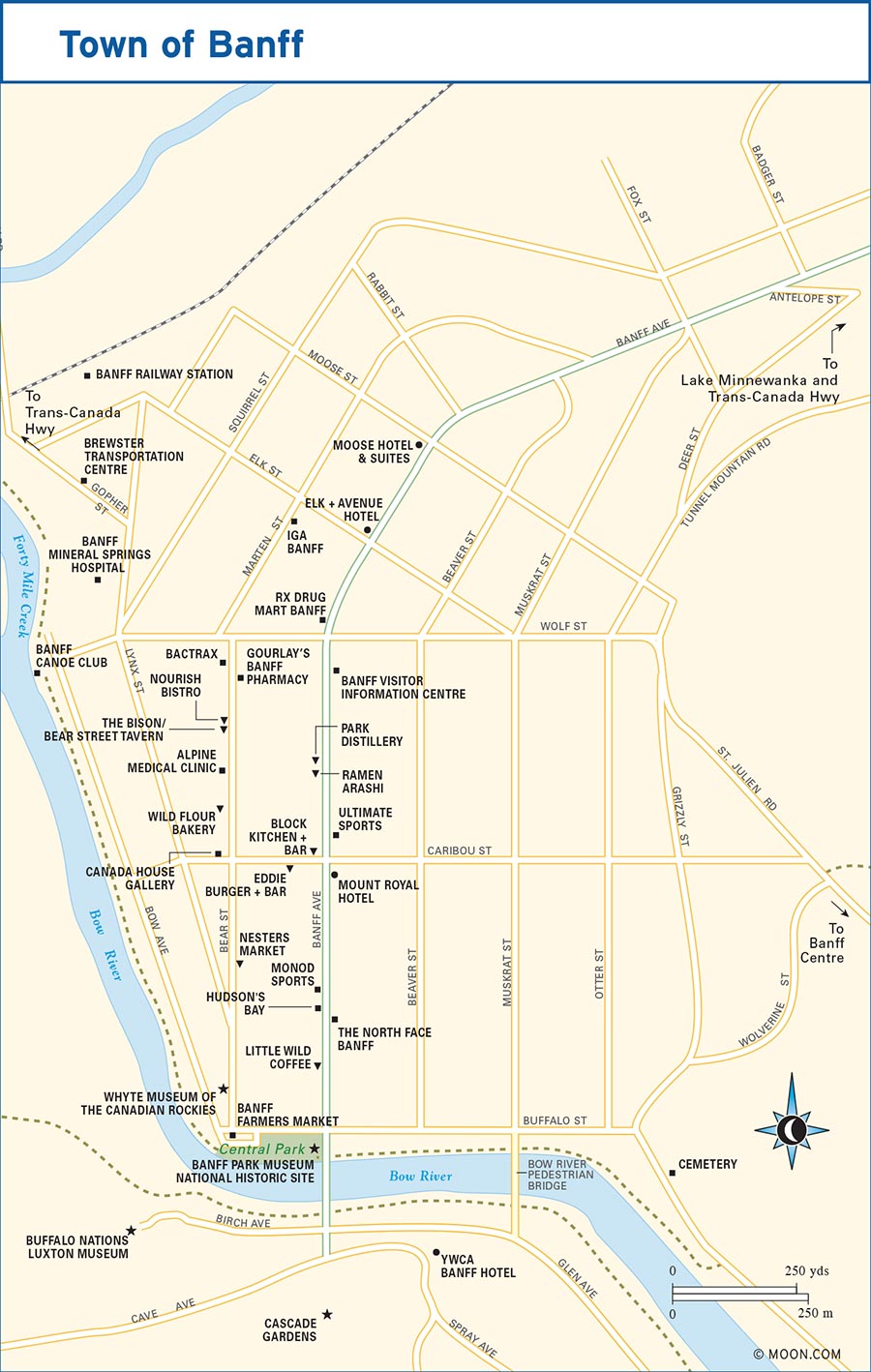
Most of the park’s accommodations, restaurants, and services are in town, as are some national park sights, along with numerous other privately run museums, gardens, and attractions. There’s plenty to see and do.
The Bow River bisects the town. The town center, many of its restaurants and shops, the Banff Centre, and Tunnel Mountain are located between Highway 1 and the river. The Cave and Basin National Historic Site, Banff Upper Hot Springs, Banff Gondola, and the famous Fairmont Banff Springs Hotel are all south of the river.
How did Banff become Canada’s first national park? The story begins with a bubbling mineral spring in an underground cave.
The Cave and Basin National Historic Site (311 Cave St., 403/762-1566, www.pc.gc.ca, 9am-5pm daily mid-May-mid-Oct., 11am-5pm Wed.-Sun. mid-Oct.-mid-May, adults $3.90, seniors $3.40) tells the park’s story, beginning in 1883 when three railroad workers stumbled on a sulfurous spring in a grotto—the Cave that you can still walk into today, through a dimly lit rock-lined tunnel. Through exhibits at this historic site, you can learn more about the development of Canada’s national park system and about the hot springs in the area. You can also check out the Basin hot springs pool (although you can no longer take a soak here). If you want to take the waters, visit Banff Upper Hot Springs; the Thermal Waters Pass (adults $11.35, seniors $9.95, families $30.05) covers admission to Banff Upper Hot Springs and the Cave and Basin NHS.
The Cave and Basin area also played a role during World War I, when the site housed a wartime internment camp, one of 24 camps in Canada for prisoners of war, most of whom were civilians of German or Eastern European heritage. Overall, Canada interned 8,579 people between 1914 and 1920. An on-site exhibit tells you more about this sobering history.
The Cave and Basin National Historic Site is across the Bow River from the town center. Cross the Banff Avenue bridge, turn right onto Cave Avenue, and continue for 0.8 mile (1.3 km) to the museum.
Spring-fall, you can get to the site on Roam Transit Route 4: Cave and Basin bus (www.roamtransit.com, 9am-6:25pm Fri.-Sun. late May-mid.-June and daily mid-June-mid-Sept., one-way adults $2, seniors and ages 6-18 $1, day pass $5) from town.
Journalist, adventurer, and entrepreneur Norman Luxton (1876-1962), along with sea captain John Voss, attempted to sail around the world in a 100-year-old, 30-foot (9-m) red cedar dugout canoe, setting off from Victoria in 1901. After stops in Tahiti and Samoa, they reached Fiji, where Luxton, ill with fever, had to abandon the endeavor; Voss eventually reached England in 1904. Luxton made his way to Banff, hoping that the mountain climate would help him return to health.
Luxton took over the then-bankrupt Crag and Canyon newspaper, remaining as publisher from 1902 until 1951. In the 1950s he decided that he wanted to establish a museum.
This quirky, old-style gallery, in a fort-like structure now called the Buffalo Nations Luxton Museum (1 Birch Ave., 403/762-2388, www.buffalonationsmuseum.com, 10am-7pm daily May-Sept., 11am-5pm daily Oct.-Apr., adults $10, seniors $9, ages 7-17 $5), has exhibits about the First Nations people, primarily of the Rockies and plains regions. It showcases beadwork, drums, pipes, and taxidermy animals. Among the more unusual artifacts are a 6,000-year-old bison skull that was unearthed in downtown Banff and dioramas of the Sun Dance ritual, which involved piercing and other self-torture.
From the town center, cross the Banff Avenue bridge, turn right onto Cave Avenue, and make the first right onto Birch Avenue.
You can (sometimes) escape from downtown Banff’s crowds at Cascade Gardens (Cave Ave. at Banff Ave., dawn-dusk daily, free), peaceful flower gardens with fanciful burl log bridges and benches, terraced into the hill behind the 1936 park administration building. The gardens are open year-round, weather permitting; the flowers are most vibrant between June and September.
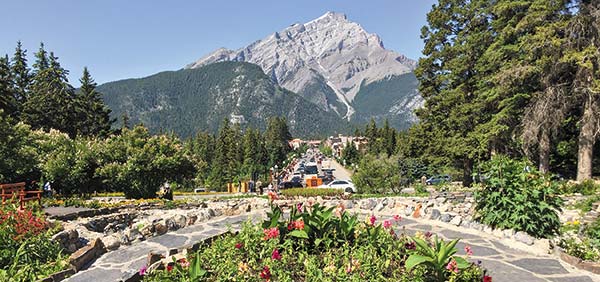
views of Banff from Cascade Gardens
A classic Banff photo spot is in front of the administration building, looking across the gardens through town to Cascade Mountain beyond.
From town, follow Banff Avenue over the bridge across the Bow River, and the gardens are directly in front of you.
You can’t bathe at the Cave and Basin National Historic Site, where the discovery of an underground spring led to the creation of Banff National Park, but you can soak in the mineral pools high on Sulphur Mountain at Banff Upper Hot Springs (1 Mountain Ave., 403/762-1515 or 800/767-1611, www.hotsprings.ca, 9am-11pm daily mid-May-mid-Oct., 10am-10pm Sun.-Thurs., 10am-11pm Fri.-Sat. Nov.-mid-May, last admission 30 minutes before closing, adults $8.30, seniors $7.30, ages 3-17 $6.30, families $24.50).
The first bathhouse here was built in 1886, though the current Queen Anne Revival stone bathhouse, which was constructed as a Depression-era unemployment relief project, dates to 1932. At 5,200 feet (1,585 m), surrounded by mountains, the Upper Hot Springs are at the highest elevation of any mineral springs in Canada.
The pool waters are kept between 98°F and 104°F (37-40°C). The minerals that give the waters their unique composition are a mix of sulfate, calcium, bicarbonate, magnesium, and sodium. You can rent towels ($1.90) and swimsuits ($1.90), including historical “bathing costumes.” Lockers are available. The Thermal Waters Pass (adults $11.35, seniors $9.95, families $30.05) covers admission to both the hot springs and the Cave and Basin National Historic Site. Note: The hot springs are closed mid-late October for annual maintenance.
Banff Upper Hot Springs is 2.5 miles (4 km) south of town. Follow Banff Avenue over the Bow River, turn left onto Spray Avenue, then turn right onto Mountain Avenue and follow the signs for 2.2 miles (3.5 km) to the hot springs parking lot.
You can also take the Roam Transit Route 1: Sulphur Mountain bus (www.roamtransit.com, 6:15am-11:30pm daily, one-way adults $2, seniors and ages 6-18 $1, day pass $5) between town and the springs.
The Banff Gondola (Mountain Ave., Sulphur Mountain, 403/762-2523, www.banffjaspercollection.com, 9am-8:30pm daily Apr.-mid-May, 8am-9:30pm daily mid-May-June and early-Sept.-mid-Oct., 8am-10:30pm daily July-early-Sept., 10am-4:30pm Mon.-Tues. and 10am-8:30pm Wed.-Sun. mid-Oct.-Mar., adults $64, ages 6-15 $32) whisks you to the top of Sulphur Mountain, an eight-minute ride to an elevation of 7,486 feet (2,281 m), where views of six surrounding mountain ranges spread out in all directions. The original gondola, which opened on this site in 1959, was the first in Canada.
When you reach the Summit Building at the top of the gondola, go up to the top (4th) floor observation deck for 360-degree views of the mountain peaks. You can stop for a meal at the cafeteria-style Northern Lights or in the window-lined Sky Bistro for a more elevated experience.
Outside the Summit Building, follow the Sulphur Mountain Boardwalk, a 0.6-mile (1-km) pathway that leads to several observation platforms and to the Sanson Peak Weather Observatory, a historic observatory station that opened in 1903. It’s named for Norman Bethune Sanson (1862-1949), who hiked up to this station more than 1,000 times over a 30-year period to monitor the area weather. Sanson also served as the curator of the Banff Park Museum from 1896 to 1932.
If you’d like to follow in Sanson’s footsteps and hike Sulphur Mountain yourself instead of riding up in the gondola, follow the 3.5-mile (5.6-km) Sulphur Mountain Trail. It starts from the Upper Hot Springs parking lot on Mountain Avenue and switchbacks up the mountain slopes, with an elevation gain of 2,149 feet (655 m). You can purchase a one-way gondola ticket (mid-May-mid-Oct. adults $32, ages 6-15 $16, mid-Oct.-mid-May free) to save your knees from the hike back down. Note that if you want to ride the gondola up and hike down, there’s no discount; you have to buy a regular full-price gondola ticket.
In summer, when the gondola gets especially busy midday, visit before 10am or after 6pm to avoid long lines. Buy your tickets online 48 hours in advance for a 10 percent discount.
The Banff Gondola is located 2.6 miles (4.2 km) south of town, beyond Banff Upper Hot Springs. Follow Banff Avenue over the Bow River, turn left onto Spray Avenue, then turn right onto Mountain Avenue, which leads up to the gondola parking area.
The Roam Transit Route 1: Sulphur Mountain bus (www.roamtransit.com, 6:15am-11:30pm daily, one-way adults $2, seniors and ages 6-18 $1, day pass $5) can take you between town and the gondola.
Built in 1888 as one of the original Canadian Pacific Railway hotels, the Fairmont Banff Springs Hotel (405 Spray Ave., 403/762-2211 or 866/540-4406, www.fairmont.com) is as much a landmark as it is a lodging. While fire destroyed the original wooden hotel building, the stately stone château that now stands on the site, with more than 700 guest rooms, was constructed in 1928, and is designated a National Historic Site of Canada. Even if you’re not staying at “The Castle in the Rockies,” you might want to explore its grand public spaces, have a drink on its mountain-view terrace, or book afternoon tea in the Rundle Lounge (noon-3:30pm daily, $55, reservations recommended).
The hotel is on the south side of the Bow River. From town, cross the Banff Avenue bridge, turn left onto Spray Avenue, and follow it 1 mile (1.6 km) to the hotel.
TIP: To take those iconic photos of the Fairmont Banff Springs Hotel surrounded by forests and backed by the mountains, you need to get some distance away from the hotel. From town, follow Buffalo Street toward the Banff Centre. The point where the road turns sharply uphill is known as Surprise Corner. Pull off here, walk up to the lookout platform above the Bow River, and you’ll see the hotel standing regally amid the trees.
Wandering into the Banff Park Museum National Historic Site (91 Banff Ave., 403/762-1558, www.pc.gc.ca, 10am-6pm daily mid-May-mid-Oct., 11am-5pm Sat.-Sun. mid-Oct.-mid-May, adults $3.90, seniors $3.40) is like stumbling into the home of a 19th-century mountain explorer.
Opened in 1903, the log building still has its original honey-hued wood paneling. Most of the collection, which includes taxidermy bears, bison, big-horned sheep, birds, and other animals native to the Banff area, was acquired between 1900 and the 1930s. The museum’s oldest specimen, a red-breasted merganser, was mounted in 1860—before Canada had even become Canada.
Head upstairs to find the “cabinet of curiosities,” housing various oddities that people donated to the museum.
Founded by local artists and philanthropists Peter Whyte and Catharine Robb Whyte, the Whyte Museum of the Canadian Rockies (111 Bear St., 403/762-2291, www.whyte.org, 10am-5pm daily, adults $10, seniors $9, students 12 and over $5) explores mountain history, art, and culture.
Exhibits showcase the Rocky Mountains’ First Nations communities, early explorers, and mountain guides and skiers who helped develop the area for winter tourism. The museum also has an art gallery with a changing roster of exhibitions.
On summer weekends, the museum offers 60-minute Banff Historic Walking Tours, with stories about the people who helped build the town. Check the museum website for schedules.
Brewster Sightseeing (403/762-6700 or 866/360-8839, www.banffjaspercollection.com) offers several Banff tours (4.5-6 hours, adults $135-175, ages 6-15 $68-88), with options that include the Banff Gondola, a Lake Minnewanka cruise, or both. It also runs these day tours of Banff starting in Calgary or Canmore. From Banff, it operates tours to Lake Louise, the Columbia Icefield, and Jasper as well. Buy tickets online or at its Explore Rockies Activity Centres at the Brewster Transportation Centre (100 Gopher St., 800/760-6934, 7am-9pm daily), Elk + Avenue Hotel (333 Banff Ave., 403/760-3291, 7am-10pm daily), Mount Royal Hotel (138 Banff Ave., 403/760-8557, 7am-9pm daily), or Cave and Basin (311 Cave Ave., 403/760-3353, 11am-5pm Wed.-Sun.). The company also has an office at the Banff Gondola (Mountain Ave., 403/762-7475), open during the gondola’s operating hours.
Discover Banff Tours (Sundance Mall, 215 Banff Ave., 403/760-5007 or 877/565-9372, www.banfftours.com, 8am-6pm daily) offers a Discover Banff & Its Wildlife Tour (Apr.-Nov., 3 hours, adults $68, ages 6-12 $35), with stops at Bow Falls, the Fairmont Banff Springs Hotel, Surprise Corner, and Lake Minnewanka. From Banff, the company also runs half-day and full-day tours for Lake Louise, guided hiking tours, helicopter tours, and horseback riding tours.
Starting right in town, a popular intermediate-level hike goes up the Tunnel Mountain Trail to a lookout point with views across the Bow Valley. The trail is 3 miles (4.8 km) round-trip, with a series of switchbacks to moderate the climb; the elevation gain is 850 feet (260 m). The trailhead is near the Banff Centre on St. Julien Road.
Another hike to take for its panoramic views is the Sulphur Mountain Trail. The trailhead starts from the Upper Hot Springs parking lot on Mountain Avenue and switchbacks up the mountain slopes, with an elevation gain of 2,149 feet (655 m). The trail is 3.5 miles (5.6 km) each way. If you don’t want to walk back down, you can purchase a one-way ticket on the Banff Gondola (403/762-2523, www.banffjaspercollection.com, mid-May-mid-Oct. adults $32, ages 6-15 $16, mid-Oct.-mid-May free).
The Surprise Corner to Hoodoos Trail (3 mi/4.8 km each way) is an easy hike along the Bow River to a group of hoodoos, unusual limestone rock formations. The trail begins at Surprise Corner (Buffalo St.), which also has an overlook with views to the Fairmont Banff Springs Hotel. For a one-way walk, catch the Roam Transit Route 2: Tunnel Mountain bus (www.roamtransit.com, 6:15am-11:30pm daily, one-way adults $2, seniors and ages 6-18 $1, day pass $5) back to town from Tunnel Mountain Campground.
Take a laid-back paddle down the Bow River with a canoe or kayak rental from the Banff Canoe Club (403/762-5005, www.banffcanoeclub.com, 10am-6pm daily mid-May-mid-Oct., $40 per hour, $20 each additional hour). Its docks are on the riverbank at the corner of Wolf Street and Bow Avenue. It also offers 1.5-hour guided tours in 12-passenger voyageur canoes, including River Explorer Big Canoe Tours (11am, 1pm, and 3:30pm daily mid-May-mid-Oct., adults $54, ages 6-12 $25) and Wildlife on the Bow Big Canoe Tours (9am Sat.-Sun. and 6pm daily June, 9am and 6pm daily July-Aug., 6pm daily Sept., adults $54, ages 6-12 $25).
The Rocky Mountain Legacy Trail (403/762-1556, www.pc.gc.ca) is a paved 17-mile (27-km) multiuse path that begins at the Bow Valley Parkway and travels through the town of Banff before running parallel to Highway 1 east to the town of Canmore. Nearly 14 miles (22 km) of the route are within the boundaries of Banff National Park, where it’s known as the Banff Legacy Trail. Pick up a trail map at area visitors centers or online from the Banff National Park website.
Rent bikes from Bactrax (225 Bear St., 403/762-8177, www.snowtips-bactrax.com, 8am-8pm daily, 1 hour $10-16, full-day $35-60) or Ultimate Sports (206 Banff Ave., 403/762-0547, www.ultimatebanff.com, 8am-9pm daily, 1 hour $10-15, full-day $35-60). Bike rentals from Banff Cycle (403/985-4848, www.banffcycle.com, full-day $50-150) include free delivery and pick-up from any location in Banff.
The Banff Centre (107 Tunnel Mountain Dr., box office 403/762-6301 or 800/413-8368, www.banffcentre.ca) describes itself as “the largest arts and creativity incubator on the planet.” Established in the 1930s as the Banff School of Drama, and quickly renamed the Banff School of Fine Arts, the Banff Centre provides professional development and training programs in a variety of artistic fields, including music, theater, dance, literature, painting, photography, sculpture, film, and new media. This campus-like complex of buildings on a hill overlooking the town presents a full calendar of performances, events, and exhibitions that are open to the public.
All summer long, the Banff Summer Arts Festival (www.banffcentre.ca, June-Aug.) presents more than 100 events, including concerts, dance, lectures, readings, and films on the Banff Centre campus.
The Banff Centre also hosts the Banff Mountain Film and Book Festival (www.banffcentre.ca, Oct.-Nov.), nine days of movies, book talks, lectures, and other events that incorporate a mountain theme.
Get started on your holiday shopping at the Banff Christmas Market (www.banffchristmasmarket.com, Nov.), or bring the family to the annual Santa Claus Parade of Lights (Nov.).
Canada House Gallery (201 Bear St., 800/419-1298, www.canadahouse.com, 9:30am-6pm Sun.-Thurs., 9:30am-7pm Fri.-Sat.) shows work by Canadian artists, including Inuit art from Canada’s Arctic regions.
Banff has several outdoor gear shops, including Monod Sports (129 Banff Ave., 403/762-4571 or 866/956-6663, www.monodsports.com, 10am-8pm daily) and The North Face Banff (124 Banff Ave., 403/762-0775, www.thenorthfacebanff.ca, 9am-10pm daily).
Ultimate Sports (206 Banff Ave., 403/762-0547, www.ultimatebanff.com, 7am-9pm daily) sells and rents gear for skiing, snowboarding, and cycling. Bactrax (225 Bear St. 403/762-8177, www.campingbanff.com, 8am-8pm daily) rents camping gear, including tents, sleeping bags, and cooking supplies.
There’s a branch of the Hudson’s Bay (125 Banff Ave., 403/762-5525, www.thebay.com, 10am-7pm Sun.-Thurs., 10am-9pm Fri.-Sat.) department store in the center of town.
Yes, you can sample buffalo and other game at S The Sleeping Buffalo (700 Tunnel Mountain Rd., 403/760-4484, www.crmr.com, noon-5pm and 5:30pm-9pm daily, lunch $14-20, dinner $26-40), from a buffalo duo of grilled strip loin and braised short ribs to the house-made charcuterie platter, a sharing plate for two, with air-dried elk, smoked duck breast, and wild boar pâté. There are also west coast seafood options if meat isn’t your thing. There’s nothing sleepy about this upscale wood-beamed dining room at Buffalo Mountain Lodge, although you may need a nap after the warm chocolate molten cake, served with caramel sauce and Amaretto ice cream.
S Juniper Bistro (Juniper Hotel, 1 Juniper Way, 403/763-6219, www.thejuniper.com, 7am-11am and 5pm-9pm Mon.-Thurs., 7am-11am and 5pm-10pm Fri., 7am-2pm and 5pm-10pm Sat., 7am-2pm and 5pm-9pm Sun., breakfast $10-15, dinner $17-35) starts with a lovely setting, with a wall of windows facing the mountains and a spacious outdoor terrace with even better views. It’s an excellent choice for a leisurely breakfast, with creative plates like eggs Benedict smothered with braised rabbit over bannock, huevos rancheros topped with barbecue pork, or a breakfast salad with kale, greens, goat cheese, and poached eggs. In the evening, try a colorful vegetarian plate of yellow, pink, and red beets with roasted Brussels sprouts and yams, an Alberta wild boar chop with grilled fruit, or sea bass seasoned with olives, pine nuts, and anchovies. Nearly all the wines and beers are Canadian, so drink local, eh?
Ride the Banff Gondola to the S Sky Bistro (Sulphur Mountain, 403/762-7486, www.banffjaspercollection.com, 11am-4:30pm Mon.-Tues. and 11am-8:30pm Wed.-Sun. late Jan.-Mar., 11am-8:30pm daily Apr.-mid-May, 11am-9:30pm daily mid-May-June and early Sept.-mid-Oct., 11am-10:30pm daily July-early Sept., 11am-8:30pm Wed.-Sun. mid-Oct.-late Jan., lunch $17-22, dinner $28-39) for a contemporary meal with expansive vistas over the mountains, an especially atmospheric setting at sunset. Up here at 7,510 feet (2,290 m), you could share squash fritters or Alberta beef tartar with pickled egg yolk, then dig into locally raised lamb with toasted pumpkin seeds and sun-dried tomato pesto, a pork trio of local belly, pulled shoulder, and smoked hock stew, or a meal-sized citrus-dressed ancient grains salad with root vegetables, chard, and broccolini. Linger over the classic strawberry shortcake or the “gourmet PB&J bar,” a childhood fantasy grown up, with layers of dark chocolate ganache, peanut butter mousse, and grape jelly. Packages including gondola tickets and meals are available; check the website or phone for details.
Brewing its own vodka, gin, and rye, and serving fun “campfire food,” Park Distillery (219 Banff Ave., 403/762-5114, www.parkdistillery.com, 11am-10pm daily, lunch $15-25, dinner $20-48), a lively ski lodge-style pub, turns out plates like wild trout, rotisserie chicken, and Alberta sirloin from a wood-fired grill, and there’s a long list of spirits and brews beyond its own. To get the scoop on the spirited scene, take a free 30-minute distillery tour (3:30pm daily, reservations recommended).
Where’s the wildlife at The Bison (211 Bear St., 403/762-5550, www.thebison.ca, 5pm-10pm Mon.-Sat., 10am-2pm and 5pm-10pm Sun., brunch $15-18, dinner $23-56)? The chefs can get wild in the open kitchen at this bustling bistro, where the 2nd-floor dining room overlooks town and the mountains. And there’s wildlife on the plates, too, when you graze on starters like escargots with bone marrow and bacon lardons or roasted scallops with chickpeas and crispy kale, before going where the signature bison roam: bison tataki (bison seasoned with a soy-citrus sauce and lightly seared), bison rib eye with chimichurri, or the classic bison short ribs, braised and served with baby potatoes.
When you’re on the lookout for light bites and cocktails, there’s Block Kitchen + Bar (5-201 Banff Ave., 403/985-2887, www.banffblock.com, 11:30am-10pm Sun.-Thurs, 11:30am-10:30pm Fri.-Sat., lunch $15-19, all-day small plates $8-36). From midday to late night, the Mediterranean-Asian sharing plates travel from vegetable samosas to Silk Road chicken skewers to smoked bison flatbread. At lunch, you can choose from a menu of world-roaming sandwiches, like a beef brisket “naanwich” or a black rice and falafel patty topped with smoked cheddar.
To dine before a show, or to enjoy fine modern fare with a valley view, head to the Banff Centre and its Three Ravens Restaurant (Sally Borden Bldg., 4th Fl., 107 Tunnel Mountain Dr., 403/762-6300, www.banffcentre.ca, 5pm-9pm daily, $30-41), where there’s plenty to applaud on the imaginative menu. You might open with a salad of greens, quinoa, and coffee-braised carrots or braised Alberta lamb with ricotta gnocchi, before a second act of juniper-rubbed elk, steelhead trout with roasted peppers, or bison tenderloin paired with farro and candied yams. A more relaxed Banff Centre dining option is MacLab Bistro (Kinnear Centre, 1st Fl., 107 Tunnel Mountain Dr., 403/762-6141, www.banffcentre.ca, 7am-2am daily, food service till midnight, breakfast $4-16, lunch and dinner $15-28), serving salads, sandwiches, burgers, pizzas, and curries, as well as pre- or post-event drinks and snacks.
Expect a line-up at Ramen Arashi (Sundance Mall, 215 Banff Ave., 403/760-0908, www.ramenarashi.com, 11am-9pm daily, $11-15), a Japanese noodle shop with fewer than 25 seats, tucked away on the 2nd floor of the Sundance Mall. The signature dish is arashi tantan men, noodles in a savory broth enriched with sesame paste and spiced with chili oil. Also popular is the flavorful tonkatsu ramen topped with barbecued pork. To drink, there’s Japanese beer, sake, and plum wine.
The choices are simple at the Bear Street Tavern (211 Bear St., 403/762-2021, www.bearstreettavern.ca, 11:30am-10pm daily, $16-22): pizza and craft beer. The pies build on the basics with options like the Tatanka (smoked bison, blue cheese, and caramelized onions) or the Wheeler Hut (wild mushrooms, pine nuts, truffle oil, and pesto). For the suds, Bear Street typically has eight local brews on tap and more microbrews in the bottle. If you’re not into pizza, there’s pork belly mac-and-cheese or smoked chicken wings with piri piri sauce. It’s on the lower level of the same space that houses The Bison restaurant.
Vegetarians, and anyone who’s eaten their fill of Alberta beef, will appreciate the interesting plant-based fare at Nourish Bistro (110-211 Bear St., 403/760-3933, www.nourishbistro.com, 11:30am-10pm daily, $15-26). On the all-day menu of plates designed to share, you can start with the popular nachos or choose from veggie burgers, a grain and plant “nourishment bowl,” or a vegan “mac and squeeze” made with quinoa noodles and coconut sauce. Several dishes come in either full or half portions.
Deep-fried pickles, saucy chicken wings, hipster hot dogs, and classic poutine may grab your attention, but at Eddie Burger + Bar (6-137 Banff Ave., 403/762-2230, www.eddieburgerbar.ca, 11:30am-2am daily, $15-21), the name says it all. You want something on a bun, whether it’s Alberta beef, bison, chicken, veggies, or even elk, and something from the bar. The milk shake bar has classics like vanilla or chocolate, newcomers like Nutella or chocolate raspberry, and “high-octane” concoctions like the Monkey’s Lunch (vanilla ice cream, Kahlúa, and crème de banana) or the Burt Reynolds (vanilla ice cream, spiced rum, and butter ripple schnapps).
Cheerful S Wild Flour Artisan Bakery (101-211 Bear St., 403/760-5074, www.wildflourbakery.ca, 7am-4pm daily, breakfast $3.50-7, lunch $6-10) is always busy, and with good reason. From pastries, house-made granola, and frittata sandwiches to good-value lunchtime combos of soup, focaccia, sandwiches, or fresh salads, like kale with apples, cranberries, and pumpkin seeds, there’s lots of deliciousness on your overflowing plate. Come at off-hours to snag a table or counter seat, or take your fresh-baked brownie, unusual fig-anise cookie, or other goodies for the trail. The same owners run Little Wild Coffee (119 Banff Ave., 403/762-0329, www.littlewildcoffee.ca, 8am-6pm daily), serving coffee and baked goods.
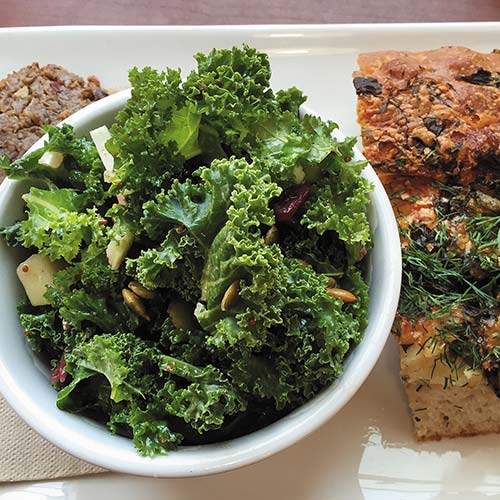
lunch at the Wild Flour Artisan Bakery
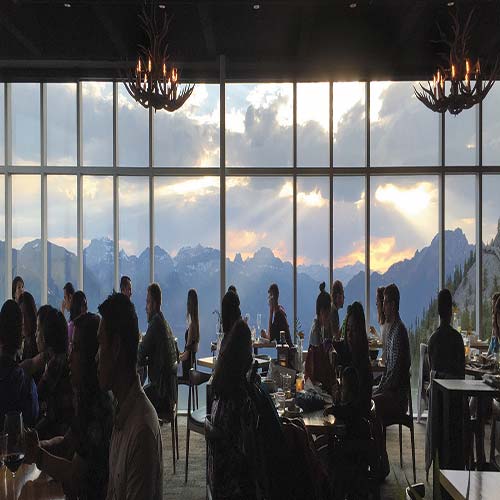
Sky Bistro at the top of the Banff Gondola
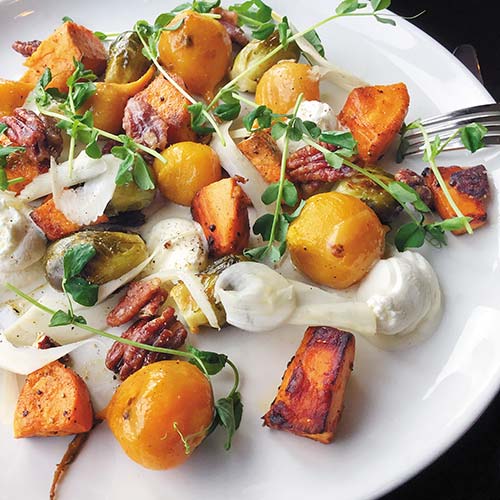
colorful vegetables at Juniper Bistro
At the Banff Farmers Market (Banff Central Park, Bear St. at Buffalo St., www.thebanfffarmersmarket.com, 10am-6pm Wed. late May-early Oct.), you can find fresh produce, bison jerky, baked goods, prepared foods, and crafts.
Banff has several grocery stores, including Nesters Market (122 Bear St., 403/762-3663, www.nestersmarket.com, 8am-11pm daily) and IGA Banff (318 Marten St., 403/762-5378, www.west.iga.ca, 8am-11pm daily).
Book early if you’re visiting in July and August, as accommodations fill up months in advance. Staying south of Banff in the town of Canmore is a reasonable alternative if Banff is overly busy.
Banff’s best budget lodging is the YWCA Banff Hotel (102 Spray Ave., 403/762-3560, www.ywcabanff.ca), in a former hospital building overlooking the Bow River, opposite Cascade Gardens. Not only does it offer simple, moderately priced rooms, but revenue from the hotel funds a local domestic violence prevention program. Double rooms ($155-210) have a bed, desk, and fan; the more expensive ones have private baths. On the lower level, bunk-bedded dorms ($40-45 pp) sleep eight; most have their own washrooms with showers. None of the rooms has a TV, but you can catch your favorite show in the lounge. There’s a shared kitchen and guest laundry; Wi-Fi, parking, and morning coffee in the lounge are free.
Banff has a busy year-round hostel, the HI-Banff Alpine Centre (801 Hidden Ridge Way, 778/328-2220 or 866/762-4122, www.hihostels.ca, $47-70 dorm, $149-235 d), off Tunnel Mountain Road. Sleeping options include four- to six-bed female, male, or mixed dorms, private doubles with a shared bath, private queens with en suite baths, and private standalone log cabins ($300-475) with two double beds, a sitting area with a sofa and TV, and a bath. All rates include Wi-Fi and a town bus pass (ask at the front desk). The hostel has a restaurant, pub, and shared kitchen; staff organize group hikes and nightlife excursions.
At the 50-room S Juniper Hotel (1 Juniper Way, 403/762-2281 or 866/551-2281, www.thejuniper.com, $189-394), a redone 1950s lodge, there’s plenty to see, inside and out, from the locally themed artwork and First Nations artifacts throughout the hallways, to the scenic vistas from the mountainside guest rooms. Rooms are mid-century-modern, with clean-lined cherry furnishings, earth-toned upholstery, and updated baths with stone counters and floors. There’s no pool, but there is a small outdoor hot tub. Open for breakfast and dinner, Juniper Bistro has an expansive mountain-view terrace. The hotel is 1.2 miles (2 km) outside the town center, at the base of the road to the Mount Norquay Ski Area. Parking and Wi-Fi are included, and you can catch a shuttle into town or to the ski hill.
While it’s best known for its arts programs, the Banff Centre (107 Tunnel Mountain Dr., 403/762-6148 or 800/884-7574, www.banffcentre.ca, $189-339) also offers hotel accommodations on its wooded campus above town. These aren’t student dorms; rather, they’re comfortable mid-range hotel rooms. The most modern units are in the Professional Development Centre, where standard rooms have dark woodsy furnishings and either one king or two queen beds; one-bedroom suites have a separate living room. A $15 facility fee covers Wi-Fi, parking, and access to the nearby Sally Borden Building, which houses a fitness center, a swimming pool, a climbing wall, and a running track, as well as several dining outlets.
Up the hill from the town center, Buffalo Mountain Lodge (700 Tunnel Mountain Rd., 403/762-2400 or 800/661-1367, www.crmr.com, $269-429) has 108 lodge-style rooms, all with wood-burning fireplaces, TVs, DVD players, included Wi-Fi, and patios or balconies, in several different buildings. The top units are the “premier” rooms in log cabin-like lodges on the property’s upper level, with pine ceilings and in-floor heating in the baths. Other accommodations are in townhouse units or standard hotel rooms. Parking is complimentary, as is ski and bike storage. You can soak in the large outdoor hot tub. The excellent Sleeping Buffalo Restaurant serves breakfast to guests and is open to the public for lunch and dinner.
Styled like an upscale mountain lodge, the Moose Hotel & Suites (345 Banff Ave., 403/760-8570, www.moosehotelandsuites.com, $249-779) has 174 guest rooms, including standard doubles and both one- and two-bedroom suites. With balconies or patios and large windows, they feel open and airy; standard amenities include Wi-Fi, parking, in-room coffeemakers, fridges, and microwaves. Head to the top floor to swim in the indoor pool or soak in the two rooftop hot tubs. A unique feature in the middle of the hotel courtyard is a restored 1913 historic house, which originally stood on the lodging’s current location.
Despite its traditional exterior, the Elk + Avenue Hotel (333 Banff Ave., 403/762-5666 or 877/442-2623, www.banffjaspercollection.com, $359-449) has 162 contemporary guest rooms, updated with gray faux-wood wallpaper, red desk chairs, coffeemakers, and modern baths. For more space, choose a junior suite with a sitting area or a loft unit with a bedroom upstairs and living space below. A whirlpool tub, sauna, and fitness facility, plus Wi-Fi and underground parking, are among the amenities. Tour operator Pursuit Collection runs the hotel, so its on-site activities office books excursions; ask about package rates for lodging and tours.
Part of the Pursuit Collection, the S Mount Royal Hotel (138 Banff Ave., 403/762-3331 or 877/442-2623, www.banffjaspercollection.com, $309-459), a sprawling boutique property in the center of town, was completely renovated in 2018. The 133 guest rooms range in size from compact heritage rooms to more spacious junior suites; all have fashionable quilted headboards, custom Canadian-made furnishings, one-cup coffeemakers, cozy robes, and sleek contemporary bathrooms. Rates include Wi-Fi and parking. Make time to chill in the hotel’s highlight: the top-floor Cascade Lounge and rooftop hot tub, with views over town to the mountains.
On Sulphur Mountain, below Banff Upper Hot Springs and the Banff Gondola, the Rimrock Resort Hotel (300 Mountain Ave., 403/762-3356 or 888/746-7625, www.rimrockresort.com, $258-888) is a classic luxury hotel. The best of the 343 rooms and suites have up-close mountain vistas. Facilities include an indoor pool, a sauna, a hot tub, a 24-hour fitness center, and a spa. Two lounges (martinis are a specialty), a casual café, and two restaurants, including the upscale French-inspired Eden, ensure that you won’t want for food or drink.
Known as “The Castle in the Rockies,” the S Fairmont Banff Springs Hotel (405 Spray Ave., 403/762-2211 or 866/540-4406, www.fairmont.com, $619-1,504, resort fee $25 per day, parking $27-41) remains both a regional landmark and the town’s most distinctive accommodations. Once you’ve settled into this stately stone manor, you might wish you had an appointment secretary to schedule all your activities, with its mountain-view indoor and outdoor pools, tennis courts, golf course, croquet lawn, bowling alley, large fitness center offering yoga and other exercise classes, and deluxe spa. Hotel guests can take a free one-hour heritage tour (1pm daily) of the property. The hotel’s 757 guest rooms range from cozy 200-square-foot (19-sq-m) nooks to expansive suites fit for a queen (yes, more than one monarch has stayed here). A day pass to the hotel’s lovely indoor mineral pools is $69 for hotel guests, $79 for nonguests; admission to the baths is complimentary with a massage, facial, or other spa treatment. The Fairmont’s numerous dining outlets include the 1888 Chop House, which focuses on wild game and Alberta beef; the Austrian-themed Waldhaus; the Rundle Lounge, which offers cocktails and light bites, as well as afternoon tea; and The Vermillion Room (www.vermillionroom.com, 7am-11am, noon-3pm, and 5pm-10pm Mon.-Fri.; 7am-3pm and 5pm-10pm Sat.-Sun., breakfast $14-34, lunch and dinner $16-65), a French-inspired all-day dining spot that serves a lavish weekend brunch (adults $55, kids $27).
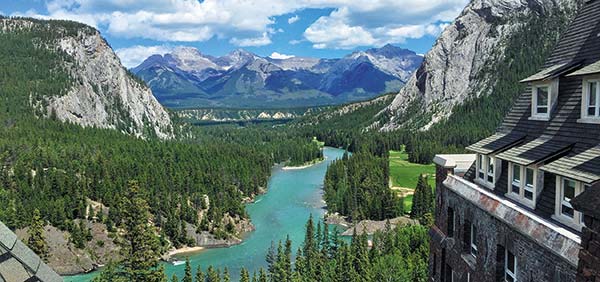
Mountains surround the Fairmont Banff Springs Hotel.
The Banff Visitor Information Centre (224 Banff Ave., 403/762-8421, www.banfflakelouise.com, 8am-8pm daily mid-May-mid-Oct., 9am-5pm daily mid-Oct.-mid-May) provides information about things to do in the area and keeps an updated list of available accommodations. Parks Canada (www.pc.gc.ca) staff are also on hand with park maps, brochures, and tips.
To learn more about Banff’s historic buildings, or to plan your own walking tour, check out the town of Banff’s online guide, Walking Through Banff’s History (www.banff.ca).
Banff’s local newspapers include The Crag and Canyon (www.thecragandcanyon.ca) and the Rocky Mountain Outlook (www.rmoutlook.com).
The Canadian Rockies edition of Where magazine (www.where.ca) lists events and other things to do in Banff, Lake Louise, and surrounding mountain areas.
Banff Mineral Springs Hospital (305 Lynx St., 403/762-2222, www.covenanthealth.ca) provides 24-hour emergency services. Alpine Medical Clinic (Unit 201A, Bison Courtyard, 211 Bear St., 403/762-3155, www.alpinemedical.ca, 8:30am-7pm Mon.-Thurs., 8:30am-5pm Fri., 9am-5pm Sat.-Sun.) accepts visitors for minor health issues.
For pharmacy services, try Gourlay’s Banff Pharmacy (220 Bear St., 403/762-2516, www.pharmachoice.com, 9am-7pm Mon.-Fri., 9am-6pm Sat., 10am-5pm Sun.) or RX Drug Mart Banff (317 Banff Ave., 403/762-2245, www.guardian-ida-pharmacies.ca, 9am-8pm Mon.-Thurs., 9am-9pm Fri.-Sat., 10am-6pm Sun.).
Highway 1, the Trans-Canada Highway, connects Banff with Lake Louise to the west and Canmore and Calgary to the east. The center of town is south of the highway and north of the Bow River. The town of Banff is compact and easy to get around on foot.
Several attractions and accommodations, including the Cave and Basin National Historic Site, Banff Upper Hot Springs, the Banff Gondola, and the Fairmont Banff Springs Hotel are on the south side of the Bow River. A bridge on Banff Avenue crosses the river.
If you’re on foot, you can cross on the Bow River Pedestrian Bridge. Built in 2013, this graceful timber footbridge across the river is east of the Banff Avenue bridge. On the town side, you can access the footbridge along the river or via the Bow River Trail, near the corner of Buffalo and Muskrat Streets. On the south side, the footbridge takes you to Glen Avenue, behind the YWCA Banff Hotel.
Banff streets get very congested, particularly in summer and fall, so you may find it less frustrating to get around on foot or by public transit.
You can park for free on the street and in a number of lots and parkades around town. Time limits vary from 15 minutes to 12 hours, so check the signs before you leave your car. On residential streets without a posted time limit, you can park for up to 72 hours.
The easiest way to find parking is using the Banff Parking app (www.banffparking.ca), which indicates where you can park for how long and how busy each location typically is. You can search for spots for cars, RVs, and bicycles. The Town of Banff (www.banff.ca) also has a parking map on its website.
Car rental companies with Banff locations include Avis (Cascade Plaza, Wolf St. at Banff Ave., 403/762-3222, www.avis.ca), Budget (202 Bear St., 403/226-1550, www.budgetcalgary.ca), Enterprise (Caribou Lodge, 521 Banff Ave., 403/762-2688, www.enterprise.ca), and Hertz (Fairmont Banff Springs Hotel, 405 Spray Ave., 403/762-2027, www.hertz.ca).
Roam Transit (403/762-0606, www.roamtransit.com) operates several bus routes throughout the Banff area. If you can match your travel times with the bus schedule, taking the bus can be a viable way to get around town. Banff was the first municipality in Canada to run an all-hybrid electric transit fleet.
Route 1: Sulphur Mountain (6:15am-11:30pm daily) travels through town along Banff Avenue, then crosses the river and follows Mountain Avenue to Banff Upper Hot Springs and the Banff Gondola.
Route 2: Tunnel Mountain (6:15am-11:30pm daily) runs from the Tunnel Mountain Campground through town along Banff Avenue, across the river, and along Spray Avenue to the Fairmont Banff Springs Hotel.
Route 4: Cave and Basin (9am-6:25pm Fri.-Sun. late May-mid.-June and daily mid-June-mid-Sept.) is a seasonal route that can take you between town, the Cave and Basin National Historic Site, Banff Upper Hot Springs, and the Banff Gondola.
To travel between Banff and Canmore, you can ride Route 3: Banff-Canmore Regional (6am-10:50pm daily).
Use the trip planner function on the Roam Transit website (www.roamtransit.com) to figure out what bus to take. The system also has a real-time bus-tracking feature that lets you know when the next bus is arriving.
Purchase local fares (one-way adults $2, seniors and ages 6-18 $1) or day passes ($5), good for multiple rides throughout the day, on the bus. You can also buy regional fares (one-way adults $6, seniors and ages 6-18 $3) or day passes (adults $15, seniors and ages 6-18 $7.50) on the Canmore buses.
Pay for your bus fares with exact change if you can. The electronic fare boxes on the buses don’t give change; if you don’t have exact change, they issue you a change voucher that you can redeem at the Bow Valley Regional Transit Customer Service Centre (221 Beaver St.), Banff Town Hall (110 Bear St.), Fairmont Banff Springs Hotel (405 Spray Ave.), Elk + Avenue Hotel (333 Banff Ave.), and other locations around town.
Transfers are free between local routes (1, 2, and 4) and are valid for up to 30 minutes. You can also transfer from the regional Route 3 to one of the local routes. If you’re starting your trip on a local route but plan to transfer to the Canmore bus, buy your regional ticket when you first board the local bus so you can transfer to the regional bus without paying an extra fare.
Banff Taxi and Taxi Taxi, both part of the Banff Transportation Group (403/762-0000, www.banfftransportation.com), provide 24-hour cab service. Taxis wait at stands around town; you can also hail them on the street or phone for a cab.
Just 16 miles (26 km) southeast of the town of Banff and 65 miles (105 km) due west of Calgary, Canmore is a quieter alternative to staying within Banff National Park. You’re close enough to make day trips to all the park sights, and the town, with a population of nearly 14,000, has attractions of its own, particularly for outdoor enthusiasts. With several good restaurants, it’s worth a stop for a meal, even if you’re only passing through.
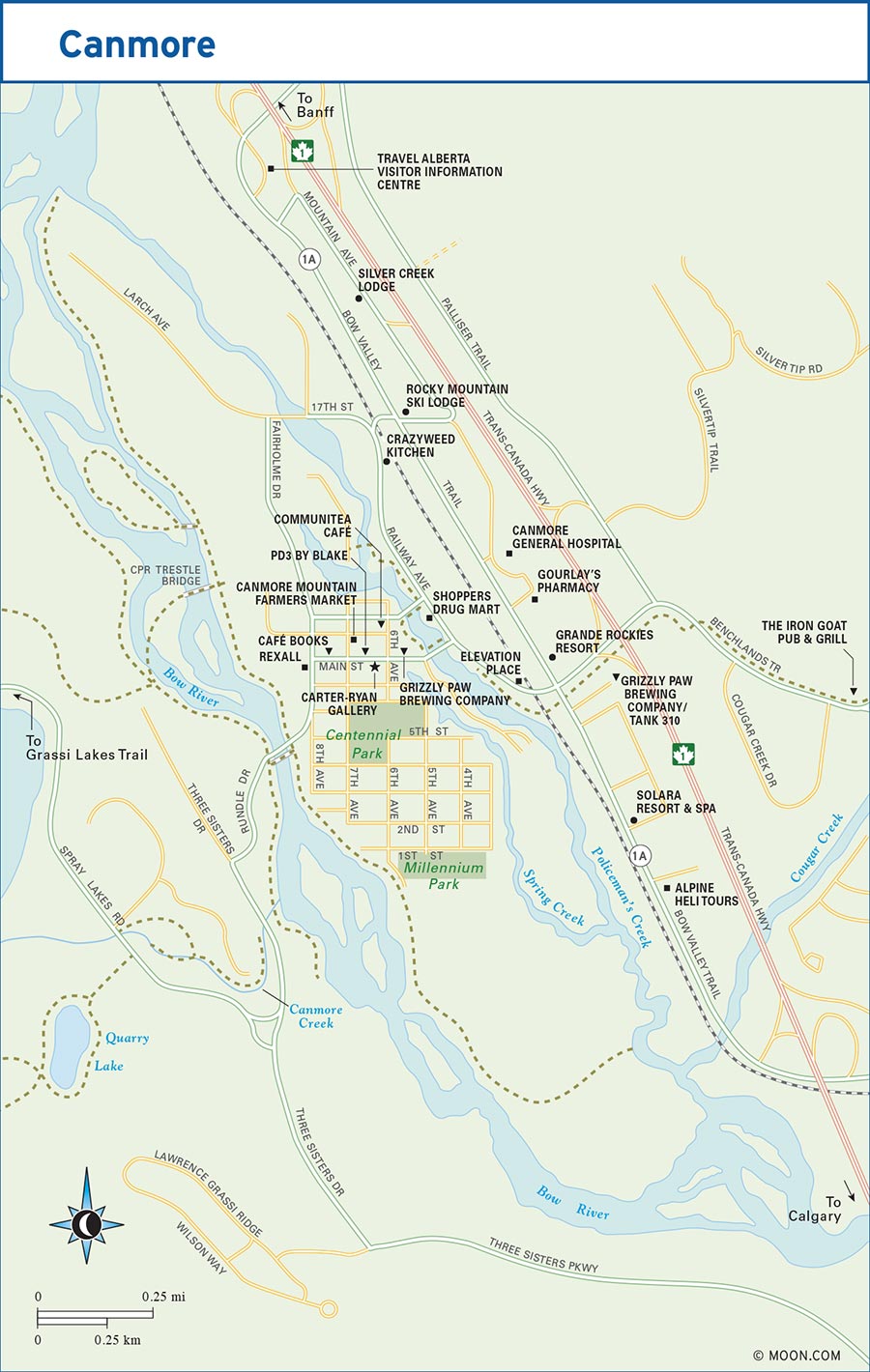
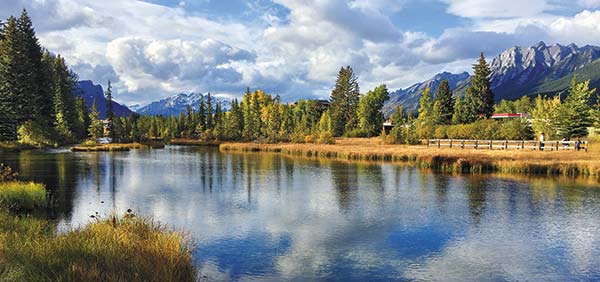
Canmore
Surrounded by mountains, Canmore is known for the Three Sisters, a triad of peaks named Faith, Charity, and Hope, also called the Big, Middle, and Little Sisters, that you can see from around the town. The Three Sisters Mountain is the highest in the Canmore area, with Big Sister rising to 9,632 feet (2,936 m).
Downtown Canmore has several art galleries to browse, including Carter-Ryan Gallery and Live Art Venue (705 Main St., 403/621-1000, www.carter-ryan.com, 10am-6pm Thurs.-Tues.), which shows the colorful paintings and the soapstone carvings of aboriginal artist Jason Carter. Also on view is artwork from the children’s book series, Who Is Boo: The Terrific Tales of One Trickster Rabbit, which Carter illustrated and author Bridget Ryan wrote. The gallery has a second location in Banff (229 Bear St., 403/985-5556, 10am-6pm Thurs.-Tues.).
Learn about the brewing process, and sample the suds, at Canmore’s first microbrewery, Grizzly Paw Brewing Company (310 Old Canmore Rd., 403/678-2487, www.thegrizzlypaw.com, tasting room 11am-5pm Mon.-Wed., 11am-9pm Thurs.-Sun., tours 2pm Wed., 1pm, 2:30pm, and 4pm Fri.-Sun.). You can also quaff the brews along with flatbreads, salads, and sandwiches at Tank 310 (noon-9pm Thurs.-Sun., $15-28), a window-lined dining spot at the brewery, or stop in for beer, burgers and other pub fare at its downtown restaurant (622 8th St., 403/678-9983, 11am-11pm Sun.-Thurs., 11am-midnight Fri.-Sat., $16-26).
Sweep over the Canmore region and get a close-up view of the Three Sisters peaks on an excursion with Alpine Heli Tours (91 Bow Valley Trail, 403/678-4802, www.alpinehelicopter.com). Tour options include the 12-minute Three Sisters Peaks Tour ($129); the 25-minute Royal Canadian Tour ($259), which starts with the Three Sisters tour route, before flying through the Goat Range Pass and along the Sundance Range in Banff National Park; and the 30-minute Mount Assiniboine Glacier Tour ($314), which adds views of the 11,870-foot (3,611-m) peak dubbed the “Matterhorn of the Canadian Rockies.”
Among Canmore’s numerous hiking routes, a favorite is the Grassi Lakes Trail, which climbs up to two turquoise ponds. This 2.4-mile (3.8-km) round-trip trail, with an elevation gain of 820 feet (250 m), has two forks. The easier branch ascends gently along a gravel road, but the more difficult route, a forest trail with a short steep section near the top, has far better views. The trailhead is off Highway 742, west of town.
When you’re ready to play indoors, head for Elevation Place (700 Railway Ave., 403/678-8920, www.elevationplace.ca, pool only adults $8, seniors and ages 18-25 $6, ages 12-17 $5, ages 3-11 $4, full facility adults $16, seniors and ages 18-25 $13, ages 12-17 $8, ages 3-11 $5), Canmore’s modern public recreation center, which has a swimming pool, fitness equipment, and a climbing gym.
Alberta’s longest-running folk fest, the Canmore Folk Music Festival (403/678-2524, www.canmorefolkfestival.com, Aug.) is a weekend-long showcase of folk, world, blues, and roots music that began back in 1978.
Fasten your seat belts, diners. Canmore’s coolest dining spot is S PD3 by Blake (806 Main St., 403/675-3663, www.blakecanmore.com, May-Oct.), in a silver 1960s double-decker bus parked in a courtyard off Main Street. It’s actually two different restaurants. PD3 Street (11:30am-late Thurs.-Tues., $13-15), a take-out window with adjacent picnic tables, serves eclectic Asian-inspired street food, like the Backpacker, a tempura shrimp taco piled with Vietnamese slaw and dressed with peanut sauce, or the Crack Wrap, a cheese tortilla stuffed with chicken, ramen, pickles, mango, and chilies. A sit-down dining room upstairs inside the bus, PD3 Upper Saloon (5pm-10pm Thurs.-Sat., prix-fixe $99) is even more adventurous; on the fixed-price menu, you might find pork belly “candy,” wild sockeye salmon with truffle ponzu, or cauliflower steak with peppered hazelnut cream and wild mushrooms.
Long considered Canmore’s best restaurant, S Crazyweed Kitchen (1600 Railway Ave., 403/609-2530, www.crazyweed.ca, 11:30am-10pm Tues.-Sun., $19-44) still charms with its inventive world-beat menu and relaxed “food is fun” vibe. You can make a meal of small plates, like the house-made labneh with honey-roasted eggplant and grilled flatbread or pickle-brined fried chicken, or a pizza from the wood-fired oven, though then you’d miss out on mains, like arctic char in a lemongrass-coconut broth or seared pork chops served with a crispy potato cake. Either way, save room for sweets, like the warm “swoon-worthy” date cake.
Perched on a hill east of the city center, The Iron Goat Pub & Grill (703 Benchlands Trail, 403/609-0222, www.irongoat.ca, 11am-11pm Mon.-Fri., 10am-11pm Sat.-Sun., $17-37) has a vast but perpetually packed patio with panoramic views of the Three Sisters and other nearby mountains. The menu has updated pub fare, including the always-requested chipotle-mango duck wings, meatloaf, pizza, and plenty of craft beer on tap.
With a long lists of teas and a vegetarian-friendly menu, bright and airy Communitea Café (117-1001 6th Ave., 403/688-2233, www.thecommunitea.com, 8am-6pm daily May-Sept., 8am-5pm Mon.-Thurs., 8am-6pm Fri.-Sun. Oct.-Apr., $7-15) can refresh you from morning till late afternoon. For breakfast, you might try the mixed berry crumble (fruit compote topped with homemade granola and yogurt), a panini, like the Chinook (wild smoked salmon, eggs, avocado, and cream cheese), or the Big Breakfast Bowl (eggs, avocado, quinoa, black beans, and sweet potatoes on a bed of spinach topped with salsa). Lunchtime brings salads, sandwiches, wraps, and rice bowls.
Café Books (100-826 Main St., 403/678-0908, www.cafebooks.ca, 9:30am-7pm Sun.-Thurs., 9:30am-9pm Fri.-Sat.) sells new and used titles and also has a tearoom (9:30am-7pm daily) across the hall from the main shop.
The Canmore Mountain Farmer’s Market (7th Ave., www.tourismcanmore.com, 10am-6pm Thurs. late May-early Oct.) sells fresh produce, baked goods, prepared foods, and crafts.
Most of Canmore’s hotels and motels are on or near the Bow Valley Trail (Hwy. 1A), which parallels Highway 1 east of the city’s downtown.
From the exterior, the Rocky Mountain Ski Lodge (1711 Bow Valley Trail, 403/678-5445 or 800/665-6111, www.canmoreskilodge.com, $119-319) says “basic motel,” but the five buildings that make up this well-maintained older lodging have a range of comfortable, updated rooms. Of the 83 units, 41 are standard guest rooms with mini fridges and included Wi-Fi, while 42 are apartment-style, such as lofts ($199-389) with a bedroom upstairs and living room below, and two-bedroom units ($199-399). Some rooms have microwaves; others have full kitchens. The family-friendly property has a hot tub, a sauna, and guest laundry; outside are barbecues, picnic tables, and a play area for the kids.
The motto at Silver Creek Lodge (1818 Mountain Ave., 403/678-4242 or 877/598-4242, www.silvercreekcanmore.ca, $119-349 d, 2-bedroom suite $159-549), which is far more upscale than the chain motels that surround it, is “Mountain Zen,” and it feels like a quiet oasis with vaguely Asian decor. Most of the 70 condo units are one- or two-bedroom suites with dark wood furnishings, electric fireplaces, sleep sofas in the living rooms, full kitchens with stone floors, soaker tubs, Wi-Fi, and washer-dryers; a few are smaller studios with kitchenettes. A small interior fitness room has weights and two cardio machines; an outdoor hot tub, a steam room, and a day spa give you more pampering options. The Wild Orchid Asian Bistro serves sushi, rice bowls, and Asian-influenced small plates.
The kids might dive right down the water slide at the S Grande Rockies Resort (901 Mountain St., 403/678-8880 or 877/223-3398, www.granderockies.com, $249-589 d, 2-bedroom suite $389-829), where the two indoor pools help make this urban-style property fun for families. Mom and Dad may head for the hot tub or compact fitness room. In the all-suite main building, the contemporary one- and two-bedroom units have full kitchens with granite countertops, stainless steel appliances, and washer-dryers. On the lobby level, Grande Kitchen + Bar serves breakfast with small plates, salads, burgers, and Alberta meats the rest of the day. If you don’t need as much space, the adjacent annex has economical studios, more like standard hotel rooms, furnished in the same modern style but without kitchen facilities. Rates include Wi-Fi and parking.
At Solara Resort & Spa (187 Kananaskis Way, 403/609-3600 or 877/778-5617, www.solararesort.ca, $289-669 d, 2-bedroom suite $409-839, 3-bedroom suite $529-1,019), the one- to three-bedroom suites sprawl across three stone and wood buildings, with an outdoor courtyard in the center of the complex. The rustic-luxe suites have full modern kitchens with a wine fridge to chill your vino, fireplaces, and washer-dryers; the premium units on the top floor have vaulted ceilings. For your workout, visit the spacious and airy fitness center, with a sauna, steam room, hot tub, and cool “relaxation” pool, as well as a full-service spa; outdoors, you can go adventuring on the complimentary bikes. An on-site movie theater shows films nightly.
Tourism Canmore (www.tourismcanmore.com) provides lots of Canmore information on its website and publishes an annual visitor guide, also available online. Stop at the Travel Alberta Visitor Information Centre (2801 Bow Valley Trail, 403-678-5277, www.travelalberta.com, 9am-5pm daily) for other information about the region.
You can get 24-hour emergency medical attention at Canmore General Hospital (1100 Hospital Pl., 403/678-5536, www.albertahealthservices.ca).
If you need pharmacy services in Canmore, try Gourlay’s Pharmacy (120-1151 Sidney St., 403/678-5288, www.gourlayscanmore.com, 9am-6pm Mon.-Fri., 10am-5pm Sat.), Rexall (901 8th St., 403/678-4301, www.rexall.ca, 9am-6pm Mon.-Sat.), or Shoppers Drug Mart (933 Railway Ave., 403/678-8750, www.shoppersdrugmart.ca, 9am-10pm daily).
Highway 1 runs through Canmore on its way between Calgary and Banff. In Canmore’s compact and walkable downtown, numbered streets run east-west; 8th Street is the main street. Numbered avenues run north-south.
Roam Transit (403/762-0606, www.roamtransit.com) runs regular buses between Canmore and Banff (6am-10:50pm daily, one-way adults $6, seniors and ages 6-18 $3, day pass adults $15, seniors and ages 6-18 $7.50).
You can ride your bike between Canmore and Banff along the paved Rocky Mountain Legacy Trail (403/762-1556, www.pc.gc.ca). It’s 14 miles (22 km) each way. If you don’t want to ride both ways, you can put your bike on the Roam Transit bus for your return trip.
Lake Louise is both a famous body of water and the name of the nearby village, located 45 minutes’ drive from the town of Banff.
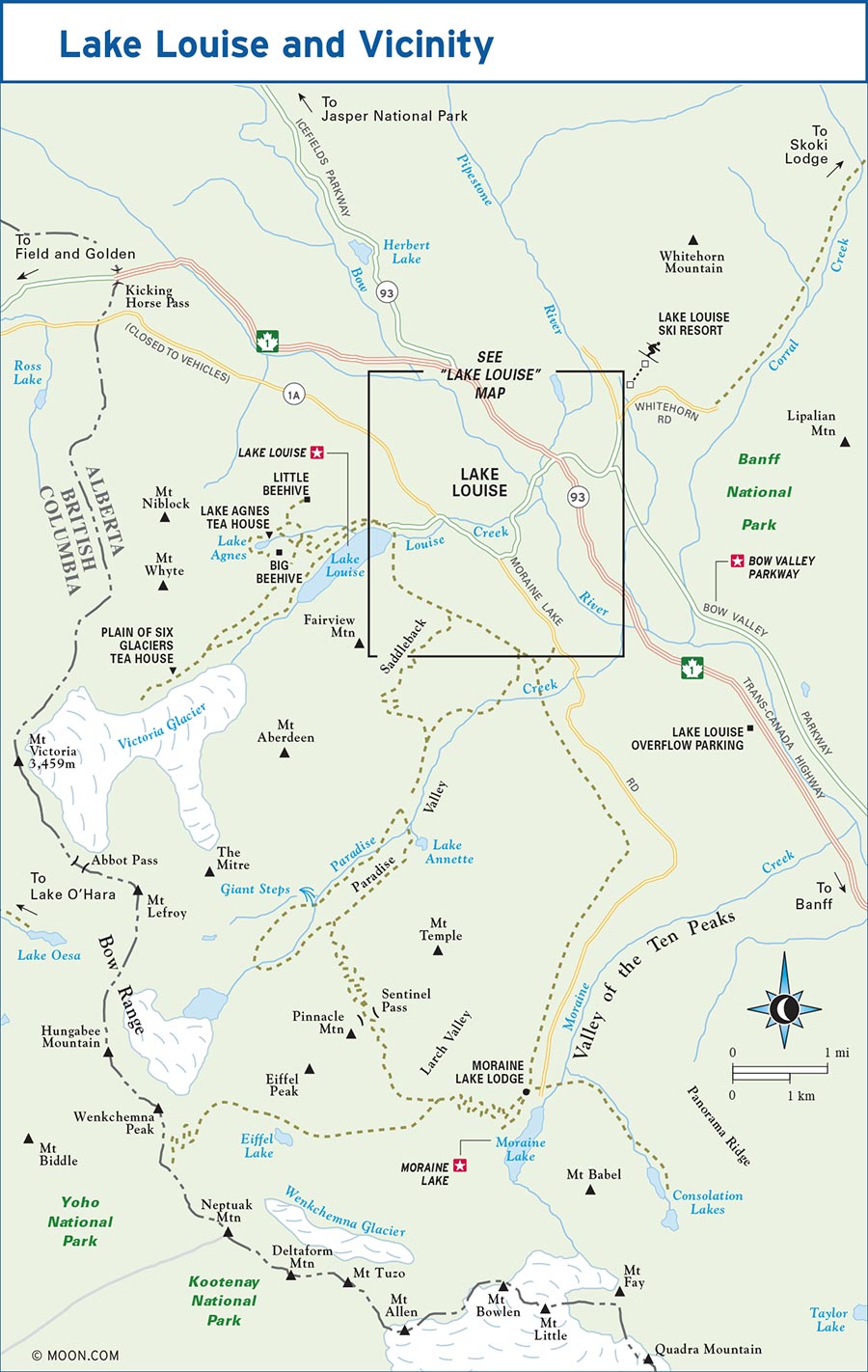
Like Banff, the village of Lake Louise, which has fewer than 1,200 residents, is within Banff National Park. However, the village isn’t a quaint community that you can stroll and explore. The area’s commercial center is the decidedly not quaint Samson Mall, a cluster of shops off Highway 1, including the visitors center, a grocery, a liquor store, and several cafés. Nearby, along Village Road, are a number of hotels.
Across the Bow River is where Lake Louise gets interesting. From here, Lake Louise Drive takes you to the famous lake, with a few lodgings and restaurants. Moraine Lake Road (open spring-fall only) leads to the area’s other notable body of water: Moraine Lake.
The main sight at Lake Louise is, of course, the lake, the brilliant blue glacier-fed body of water surrounded by mountain peaks. The ice-topped mountain that you see on the opposite side of the lake is the 11,365-foot (3,464-m) Mount Victoria, which sits on the Continental Divide between B.C. and Alberta, with the Victoria Glacier on its Lake Louise-facing side. Lake Louise is just 1.5 miles (2.4 km) long and 295 feet (90 m) deep.
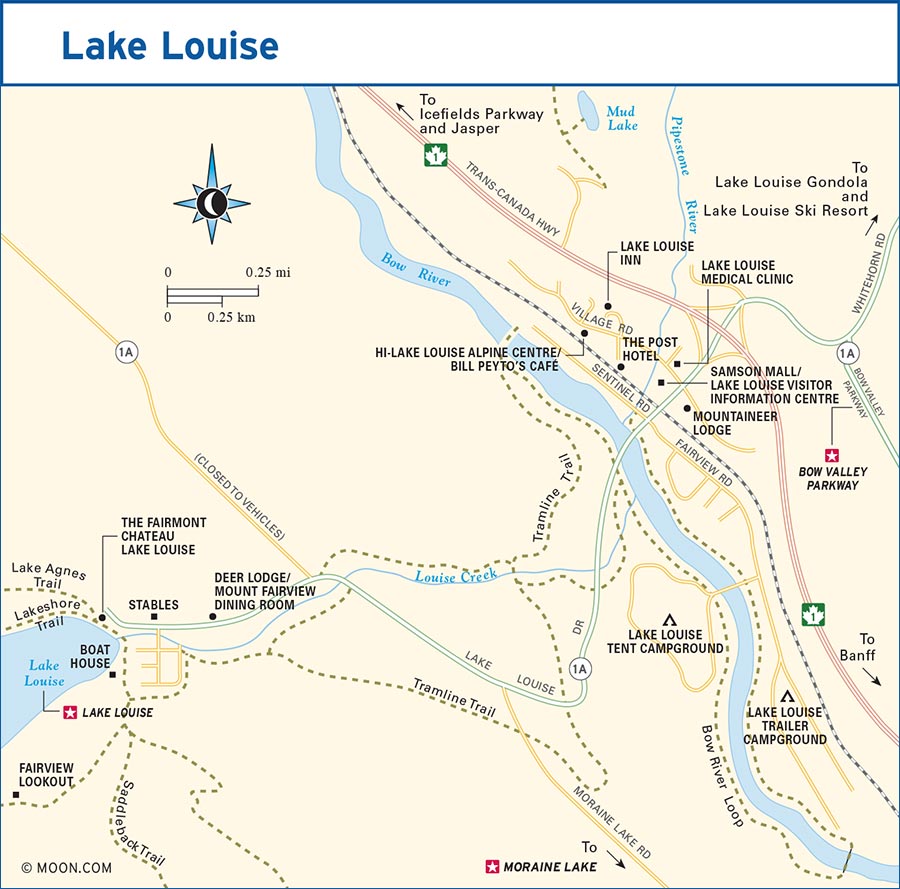
The first non-aboriginal person to see the lake, Thomas Wilson, a Canadian Pacific Railway employee whose Stoney First Nation guides brought him to the lakeshore in 1882, named it Emerald Lake for the color of its water. It was later renamed to honor Queen Victoria’s fourth daughter, Princess Louise Caroline Alberta. The blue-green lake in nearby Yoho National Park, which Wilson also named, kept the Emerald Lake title.
The castle-like structure on the lakeshore is the stately Fairmont Chateau Lake Louise (www.fairmont.com). Built by the Canadian Pacific Railway as a log chalet in the 1890s (a fire destroyed the original building), the hotel has been rebuilt and expanded, with several wings dating from 1912 to 2004. It now has more than 500 guest rooms.
The best times to visit Lake Louise are early in the morning (many people swear by the sunrise here) or late in the day, when slightly fewer sightseers are jockeying for position to take their photos in front of the famous lake. In most years, the lake is at least partly frozen from October or November into May.
Despite the crowds, Lake Louise remains a must-see on any Canadian Rockies trip. Whether you go hiking or canoeing, or simply sit by the lake, it’s one of the region’s most stunning spots.
Walk even a short distance along the Lake Louise Lakeshore Trail and you’ll get away from the hordes who cluster in front of the Fairmont hotel. The flat trail follows the lakeshore for 1.25 miles (2 km). You can’t circle the lake on foot, so return the way you came.
The short but steep Fairview Lookout Trail starts behind the Lake Louise boathouse and climbs up to viewpoints over the lake. This trail is 1.25 miles (2 km) round trip, with an elevation gain of 328 feet (100 m).
Several other hiking trails start from the lakeshore, and they can also take you away from the crowds and offer different views of the lake and surrounding mountains. If you live close to sea level, you may notice the elevation when you’re hiking near Lake Louise. The village is located at 5,033 feet (1,530 m), and many trails climb from the lakeshore into the mountains. Take it slow until you’re acclimated.
One of the most popular hikes at Lake Louise is the Lake Agnes Trail, which takes you through the forests above the lakeshore and past small Mirror Lake. Your destination is the Lake Agnes Teahouse (www.lakeagnesteahouse.com, 8am-5pm daily early June-mid-Oct., $9-15 cash only), a rustic log cabin overlooking Lake Agnes, where you can have soup and a sandwich (the homemade bread is excellent) or a pastry with a pot of tea (the teahouse carries more than 100 varieties).
This moderate 4.2-mile (6.8-km) round-trip trail does climb steadily, gaining 1,263 feet (385 m) of elevation between the lakeshore and the teahouse.
Once you arrive at the teahouse, expect to wait a while for your lunch, even after you get a table; the kitchen is small and the crowds can be large.
Beyond Lake Agnes, you can climb the switchback trail to Big Beehive, a beehive-shaped crag. The trail gains 443 feet (135 m) of elevation in 1 mile (1.6 km) from Lake Agnes. Your reward for the climb is a panorama across Lake Louise.
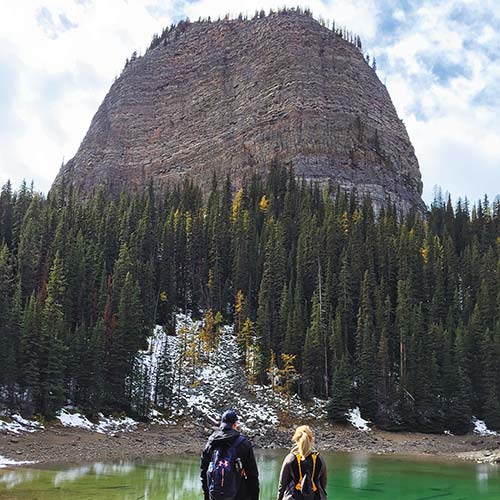
Big Beehive near Lake Agnes
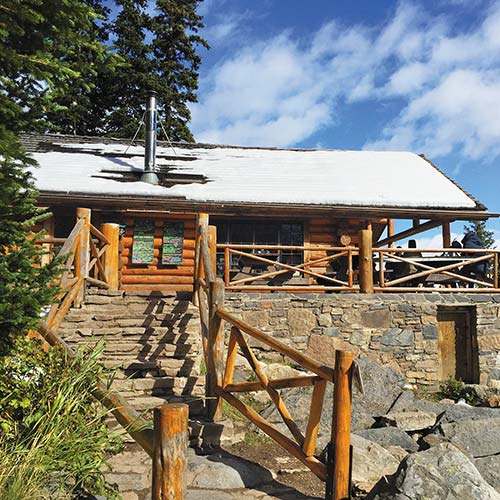
Lake Agnes Teahouse
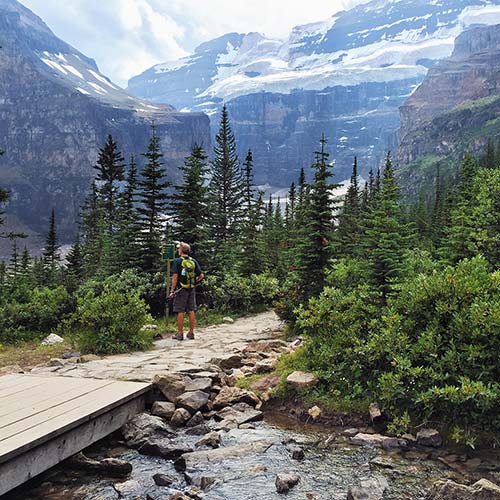
on the Plain of Six Glaciers Trail
Another side trip takes you to Little Beehive, once the site of a fire lookout, with views of the Bow Valley. This trail is 0.6 mile (1 km) each way, with a 355-foot (105-m) elevation gain from Lake Agnes.
From Lake Agnes, you can continue to the Plain of Six Glaciers Teahouse, following the Highline Trail between them. This route is 9 miles (14.5 km) total, starting and ending on the Lake Louise shore.
The Plain of Six Glaciers Trail is an intermediate-level 6.6-mile (10.6-km) round-trip route that takes you to the far side of Lake Louise, then up and between mountain peaks that are topped with glaciers year-round. This trail has an elevation gain of 1,198 feet (365 m).
The trail goes to the S Plain of Six Glaciers Teahouse (9am-6pm daily July-Aug., 9am-5pm daily late June and Sept.-mid-Oct., $9-16), where you can enjoy tea, snacks, or a light lunch; the teahouse is known for its substantial slabs of rich chocolate cake. Swiss guides working for the Canadian Pacific Railway built the stone-and-wood teahouse in 1926.
If you want to go farther, take the 2-mile (3.2-km) round-trip trail, with an elevation gain of 165 feet (50 m), to the Abbot Pass Viewpoint, where you can look down onto the Lower Victoria Glacier and look up to Abbot Hut, one of the highest buildings in Canada.
For an excellent full-day hike, you can walk to both the Lake Agnes and Plain of Six Glaciers Teahouses, following the Highline Trail between them. This route is 9 miles (14.5 km) total.
A serene way to explore the lake is by canoe. You can rent a canoe at the Fairmont Chateau Lake Louise Boathouse (8:30am-8pm daily July-Aug., 11am-7pm daily June and Sept., 30 minutes $95, 1 hour $105) on the lakeshore.
With Brewster Adventures (403/762-5454, www.brewsteradventures.com), you can visit Lake Louise’s historic teahouses on horseback on either the three-hour Lake Agnes Teahouse Half-Day Ride (9am and 1pm daily late May-mid-Oct., $157.50) or the four-hour Plain of Six Glaciers Teahouse Ride (9am and 1pm daily late May-mid-Oct., $194.25).
Brewster Sightseeing (403/762-6700 or 866/360-8839, www.banffjaspercollection.com) offers a Mountain Lakes and Waterfalls Tour (daily May-mid-Oct.), with time at Lake Louise, Moraine Lake, and Takakkaw Falls in Yoho National Park, and a barbecue lunch at Emerald Lake. You can start this tour in Lake Louise (6.75 hours, adults $175, ages 6-15 $88), Banff (9.5 hours, adults $175, ages 6-15 $88), Canmore (12.5 hours, adults $175, ages 6-15 $88), or Calgary (14.75 hours, adults $280, ages 6-15 $140). Buy tickets online, at the Explore Rockies Lake Louise office (Fairmont Chateau Lake Louise, 403/522-1695, 7:30am-5:30pm daily May-mid-Oct.), or at Brewster Sightseeing’s several Explore Rockies locations in Banff.
Discover Banff Tours (Sundance Mall, 215 Banff Ave., Banff, 403/760-5007 or 877/565-9372, www.banfftours.com, 8am-6pm daily) offers a half-day Lake Louise & Moraine Lake Tour (Apr.-Oct., 4.5 hours, adults $84, ages 6-12 $42), which begins and ends in Banff and takes you along the Bow Valley Parkway to both Lake Louise and Moraine Lake. Another option is the Deluxe Lake Louise & Moraine Lake Tour (May-Sept., 6 hours, adults $145, ages 6-12 $93), departing from Banff in the late afternoon, stopping for an early dinner at Baker Creek Bistro on the Bow Valley Parkway, and spending time at Lake Louise and Moraine Lake in the quieter evening hours, before returning to Banff.
From Highway 1 or Lake Louise Village, follow Lake Louise Drive 2.6 miles (4.2 km) to the lake. Parking is available in several lots that are tiered above the lake.
Note, however, that the parking lots near the lake frequently fill up early in the morning, at which point no cars are allowed to drive to the lake. If you’re driving to Lake Louise spring-fall, save yourself the hassle and park your car at the free overflow parking lots (mid-May-mid-Oct.) on Highway 1, outside of town. From there, you can ride the free Parks Canada shuttle bus (www.pc.gc.ca) to and from the lakeshore; confirm the seasonal shuttle schedules on the Parks Canada website.
If you’re staying in Banff, another option is to take a Parks Canada shuttle bus (7am-6:15pm daily mid-May-mid-Sept., round-trip adults $10, under age 18 free) directly from Banff to Lake Louise. Buses operate spring-fall between the Banff Heritage Train Station (327 Railway Ave.) and the lakeshore. The ride takes about 70 minutes each way.
Glacier-fed Moraine Lake, in the Valley of the Ten Peaks, is another impossibly blue body of water surrounded by sharp mountain peaks and glaciers. It’s a beautiful setting for a hike or a canoe paddle.
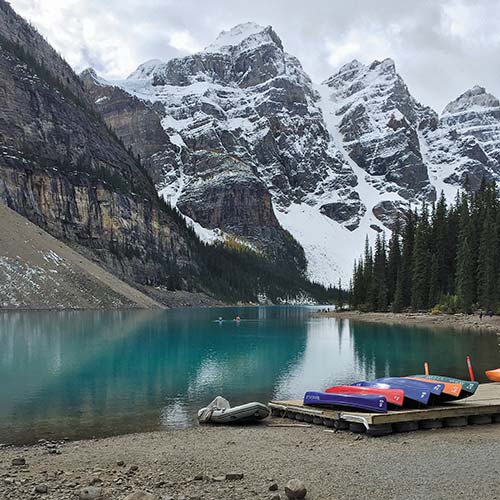
Moraine Lake
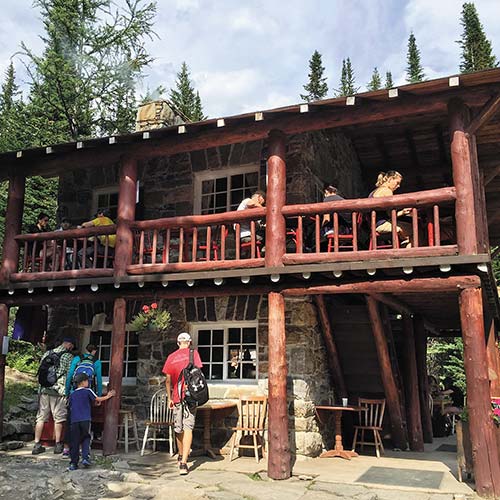
Plain of Six Glaciers Teahouse
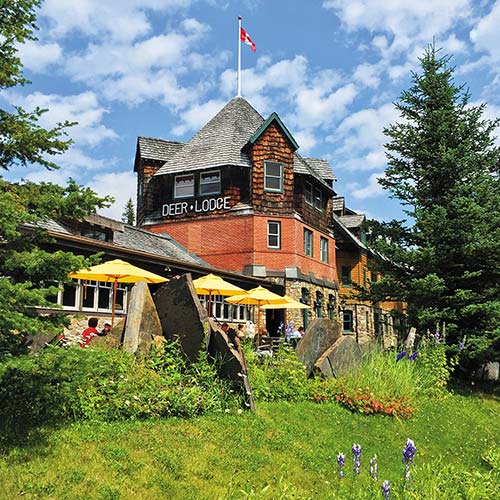
Deer Lodge
As at Lake Louise, the best times to visit Moraine Lake are in the early morning or early evening. Come at sunrise if you can, or at least before 9am; otherwise, you might consider waiting until after 5pm when the crowds thin, especially if you’re visiting in the peak months of July and August. The road to the lake is typically open only mid-May-mid-October.
The Snowshoe Café (8am-4:30pm daily June-Sept.) at Moraine Lake Lodge is a quick-service café selling sandwiches, pastries, drinks, and ice cream. In the evenings, the lodge’s lake-view Walter Wilcox Dining Room (5:30pm-9pm daily June-Sept., $34-58) accommodates hotel guests first, but nonguests can dine here if space is available.
Several hiking trails begin in the Moraine Lake area. Follow the easy Lakeshore Trail for up to 1 mile (1.6 km) along the lake.
The Consolation Lakes Trail, 3.6 miles (5.8 km) round-trip with an elevation gain of 213 feet (65 m), takes you into alpine meadows with views of the Quadra Glacier.
On the Larch Valley/Minnestimma Lakes Trail, you hike into a larch forest above Moraine Lake, with great views of the Ten Peaks. Particularly popular in September when the larch trees turn autumn gold, it’s a 5.3-mile (8.6-km) round-trip hike with a 1,755-foot (535-m) elevation gain.
Branching off from the Larch Valley Trail, the moderate Eiffel Lake Trail, which is 7 miles (11.3 km) round-trip with an elevation gain of 1,213 feet (370 m), leads up to an alpine lake with panoramas across the Valley of the Ten Peaks.
Note that Parks Canada issues seasonal bear restrictions for many of the Moraine Lake trails. During months when bears can be in the area, hikers must walk in groups of at least four and carry bear spray. Talk with park staff at the Lake Louise Visitor Information Centre (Samson Mall, 403/522-3833) or check the trail status on the Parks Canada website (www.pc.gc.ca).
One of the most peaceful ways to explore this scenic lake is by canoe. Moraine Lake Lodge rents canoes (9:30am-5pm daily mid-June-mid-Sept., $105 per hour) from a lakeside dock.
From Highway 1 or Lake Louise Village, follow Lake Louise Drive to the Moraine Lake turnoff and continue onto Moraine Lake Road. It’s 8.7 miles (14 km) from Lake Louise Village to Moraine Lake.
On busy days, the crowds at the lake can grow overwhelming. At that point, which happens regularly beginning early in the morning, Parks Canada restricts traffic on Moraine Lake Road, preventing cars from entering the road until other cars leave the area. Mountain Park Transportation (403/522-2525, www.morainelakeshuttle.ca, round-trip adults $25, ages 4-12 $15) runs a seasonal shuttle that can take you to Moraine Lake from the Samson Mall, Lake Louise Campground, or Deer Lodge. Call or check the website for the shuttle schedules.
Early September-mid-October, a free Parks Canada shuttle bus (www.pc.gc.ca) runs between the overflow parking lots on Highway 1, just outside of Lake Louise, to and from Moraine Lake; check the website for seasonal schedules.
Spring-fall, you can ride the Lake Louise Gondola (Whitehorn Dr., 403/522-3555 or 877/956-8473, www.lakelouisegondola.com, 9am-4pm daily mid-May-mid-June, 8am-5:30pm daily mid-June-July, 8am-6pm daily Aug.-early Sept., 8am-5pm daily early Sept.-mid-Oct., adults $35.95, ages 6-15 $16.95) at the Lake Louise Ski Resort to take in the views over the mountains, go hiking, visit a wildlife center, or have a drink or a meal overlooking the peaks. You might even spot a grizzly bear.
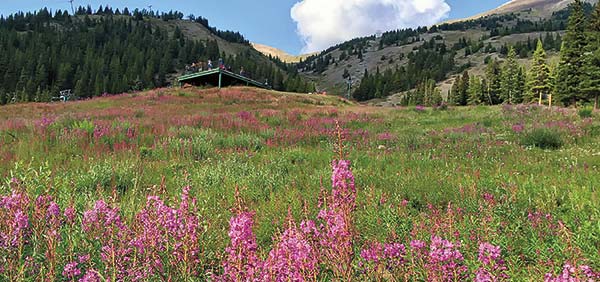
wildflowers near the Lake Louise Gondola
Scan the meadows and woods for wildlife during the 14-minute ride up to an elevation of 6,850 feet (2,088 m). In summer, grizzly and black bears come to forage for dandelions, berries, and other edibles along the slopes near the lift. You might also spot cougars, mountain goats, deer, wolves, or bighorn sheep. Check the calendar in the gondola ticket office to find out what animals the staff or other guests have recently seen.
A short walk from the top of the gondola, the Wildlife Interpretive Centre (free with gondola ticket) has exhibits about bears and other creatures, including elk, moose, bighorn sheep, deer, gray wolves, and mountain goats, that live in the region. Staff offer interpretive programs (10am, noon, and 2pm daily) about the animals and also lead guided walks, including a daily 45-minute “Trail of the Great Bear” walk (on the hour 9am-5pm daily, adults and children over age 4 $15), about bear behavior and safety, plus tips on what to do if you see a bear.
In the same building, with a lovely mountain-view patio, Whitehorn Bistro (10am-3pm daily early June-late June, 10am-4:30pm daily late June-July, 10am-5pm daily Aug.-early Sept., 10:30am-3pm daily early Sept.-mid-Oct., $21-27) serves upscale plates from salads and burgers to pheasant or rabbit fricassee with tagliatelle, along with craft beer and creative cocktails.
Several hiking trails begin at the top of the gondola. A 1.1-mile (1.7-km) round-trip loop takes you to the Kicking Horse Viewpoint, at an elevation of 7,497 feet (2,285 m). A 2.1-mile (3.4-km) round-trip trail leads to the Ptarmigan Valley Viewpoint, at 7,930 feet (2,417 m).
Since bears and other wildlife frequent the mountain’s lower slopes, you aren’t allowed to hike in this area, so you have to begin your hike at the upper gondola station. Even on the upper trails, gondola staff recommend that you don’t hike alone and suggest traveling in groups of four.
In winter, Lake Louise Ski Resort (877/956-8473, www.skilouise.com, 9am-4pm daily early Nov.-early May, full-day adults $114, seniors and ages 13-17 $89, ages 6-12 $44, under age 6 free) is the largest in the Canadian Rockies, with 145 runs and additional off-piste skiing across its 4,200 skiable acres (1,700 ha).
The gondola base is 2 miles (3.2 km) from Lake Louise Village, about a five-minute drive. Take Lake Louise Drive across Highway 1 toward the entrance to the Bow Valley Parkway. Follow the signs for the Lake Louise Ski Resort onto Whitehorn Drive.
You can catch a free shuttle to the gondola base from Lake Louise hotels or the Samson Mall. Call or check the gondola website for the shuttle pick-up schedule.
Lake Louise does not have a tremendous range of food options, and nothing is inexpensive.
TIP: The major hotels all have high-end restaurants, but most also have pubs or casual dining spots that are more moderately priced.
Known for game meats, like bison and elk, the wood-beamed S Mount Fairview Dining Room at Deer Lodge (109 Lake Louise Dr., 403/522-4202, www.crmr.com, 7am-11am and 5:30pm-9pm daily, breakfast $14-18, dinner $32-45) pleases patrons with contemporary dishes using mountain-region ingredients. Lunch is served in the log-walled Caribou Lounge (11am-10pm daily, $15-24) or out on the patio (June-Sept.). An excellent plate to share, at lunch or dinner, is the Rocky Mountain charcuterie platter, with air-dried buffalo, elk salami, smoked duck, and wild boar pâté, along with a cranberry relish and a unique pickled “mustard melon.” Other options include flatbread with duck confit and peppered pears, pan-seared salmon with citrus cucumber slaw, or elk steak with a bone marrow herb crust and pomegranate jus.
If you want to eat by the lakeshore, the Fairmont Chateau Lake Louise (111 Lake Louise Dr., dining reservations 403/522-1601, www.fairmont.com) has several dining options. For a quick bite, the cafeteria-style Chateau Deli (open 24 hours) sells sandwiches, salads, and pastries. You can try Swiss fondue, wiener schnitzel, and other European classics at The Walliser Stube (5:30pm-9pm daily, $38-55). The hotel’s main dining room, The Fairview (5:30pm-9pm daily, $41-55, 3-course prix fixe $95), prepares contemporary dishes like octopus and blood orange salad, venison with squash and black garlic, or grass-fed beef tenderloin. Like many Fairmont properties, Chateau Lake Louise offers traditional afternoon tea (noon-2:30pm daily, $52). Several of the hotel’s eateries reduce their hours in the off-season, so call or check online in advance.
You don’t have to be a hostel guest to eat at Bill Peyto’s Café (203 Village Rd., 403/522-2200, www.hihostels.ca, 7am-10pm daily summer, 7:30am-9:30pm daily winter, breakfast $7-14, lunch and dinner $13-17), the family-friendly eatery at the HI-Lake Louise hostel. You just have to appreciate hearty pub grub, including burgers, wraps, and chili, at moderate (at least for a resort town) prices. Try the elk burger. In the morning, the café serves breakfast basics: eggs, pancakes, hot cereal.
Pick up coffee and breakfast-to-go or sandwiches for a lunchtime picnic at the tiny Trailhead Café (Samson Mall, 403/522-2006, 7am-6pm daily, $8-10).
The Village Market (Samson Mall, 403/522-3894, 8:30am-8:30pm daily) sells basic groceries and picnic supplies.
Lake Louise doesn’t have any really cheap beds, but the least expensive accommodations are at the HI-Lake Louise Alpine Centre (203 Village Rd., 403/522-2201 or 866/762-4122, www.hihostels.ca, $37-52 dorm, $117-243 d) in a post-and-beam lodge on a wooded lot. The dorms sleep 4-6, in either female, male, or mixed rooms. The private rooms with shared baths come with either one double, two singles, or a bunk bed with a double and a single. You can also choose a private room with an en suite bath. Both Wi-Fi and parking are included. Two shared kitchens, a TV and games room, and a kids’ playroom give you space to hang out. The hostel’s Bill Peyto’s Café serves breakfast, lunch, and dinner.
A simple, comfortable motel, the Mountaineer Lodge (101 Village Rd., 403/522-3844 or 855/556-8473, www.mountaineerlodge.com, $200-427) has 80 rooms and suites in two buildings. In the main lodge, guests can soak in the indoor hot tub or have complimentary coffee in the sitting room; the second structure is a two-story drive-up motel block, where a complimentary breakfast buffet is served. Handy for road trippers: Rooms in both buildings include mini fridges, microwaves, coffeemakers, and Wi-Fi, and there’s a guest laundry.
Spread over five buildings, the Lake Louise Inn (210 Village Rd., 403/522-3791 or 800/661-9237, www.lakelouiseinn.com, $139-589, resort fee $8) has 244 guest rooms, ranging from basic doubles to more upscale hotel rooms to condo-style units with full kitchens, all with flat-screen TVs and Wi-Fi. The main building, where the lobby and three restaurants are located, has an indoor pool, a hot tub, and a small gym with several cardio machines. Three buildings have guest laundries. Because the rooms are all so different, ask for details or photos when you book.
The wood and stone Deer Lodge (109 Lake Louise Dr., 403/522-3991 or 800/661-1595, www.crmr.com, $169-469) was built in the 1920s, complete with a turret, a massive stone fireplace, and heavy wood beams. The compact guest rooms in the original building still have that rustic style; if you don’t need frills, they’re a good value. The newer wing’s units are much larger and more contemporary, with cherry furnishings and modern baths. The lodge has Wi-Fi included in the rates and a guest laundry; none of the rooms have TVs. Common spaces include a games room with a pool table, a sauna, and best of all, a rooftop hot tub with glacier views. The 71-room lodge is just few minutes’ walk from Lake Louise, so while you don’t have lake vistas, you don’t need your car to explore the lakeshore.
Noted Canadian modernist architect Arthur Erikson (1924-2009) designed S Moraine Lake Lodge (Moraine Lake Rd., 403/522-3733 or 877/522-2777, www.morainelake.com, June-Sept., $508-1,129), which opened in 1991, with 33 guest rooms spread out between the main lodge and several townhouse-style blocks of wood-frame cabins along the shore of the Lake Louise area’s other notable lake. Rooms have handmade log beds with down duvets, rustic furnishings, and wood floors; some units have wood-burning fireplaces. At this adult-oriented property, room rates include breakfast, canoe rentals, guided hikes with a staff naturalist, and evening interpretive programs. Dinners in the lake-view Walter Wilcox Dining Room might feature arctic char with root vegetable bruschetta, Alberta beef tenderloin, or rack of venison with pickled cabbage. The lodge operates off the grid, generating its own electricity; there’s no air-conditioning, TVs, or phones, although limited Wi-Fi is provided.
You can’t stay closer to the famous lake than at the grand S Fairmont Chateau Lake Louise (111 Lake Louise Dr., 403/522-3511 or 866/540-4413, www.fairmont.com, $599-2,499, parking $30-35). It’s hard to imagine that this lavish lakeside lodge started life as a log chalet in the 1890s (the original building was destroyed in a fire). With several wings dating from 1912 to 2004, the 550 traditional rooms vary from petite doubles overlooking the grounds or surrounding mountains to expansive suites with views across the lake. The hotel has an indoor heated pool, a fitness center, and a spa, and staff can arrange guided hikes (half-day adults $60, ages 8-12 $25, full-day adults $75, ages 8-12 $25), canoe rentals ($65 per hour), voyageur canoe tours (adults $55, ages 8-12 $30), and a variety of other activities. You can even take the hotel dog for a stroll along the lakeshore (free). Dining outlets range from a 24-hour deli to a Swiss fondue restaurant to a contemporary lake-view dining room. It’s a splurge, yes, but it’s the only lodging directly on Lake Louise. If you’re traveling outside the peak summer months, check the website for off-season specials.
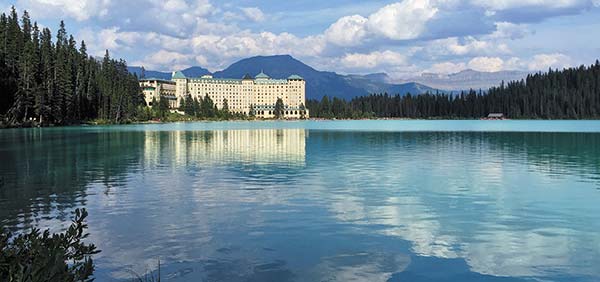
Fairmont Chateau Lake Louise
Originally built in 1942 and significantly expanded over the years, The Post Hotel (200 Pipestone Rd., 403/522-3989 or 800/661-1586, www.posthotel.com, $310-950) recalls an elegant ski lodge in the Alps, with an indoor saltwater pool, a hot tub, a fitness room, a guest library, and a full-service spa. Guests stay in 60 rooms, 29 suites, or five cabins, outfitted with simple traditional furnishings and complimentary Wi-Fi. For meals, choose from the deluxe main dining room, a fondue restaurant called Fondue Stübli, or the more casual Outpost Pub.
Parks Canada runs two campgrounds in the Lake Louise area, 0.6 mile (1 km) from the village and 2.5 miles (4 km) from the lake. Both have washrooms with flush toilets and hot showers.
The seasonal Lake Louise Tent Campground (late May-late Sept., $27.40) has 206 sites for tent campers. At the Lake Louise Trailer Campground ($32.30), the 187 fully serviced sites are open to campers year-round.
You can make campsite reservations (877/737-3783, www.reservation.parkscanada.gc.ca) online or by phone for both Lake Louise campgrounds; reservations are strongly recommended, particularly for summer and fall stays.
Both Parks Canada (www.pc.gc.ca) and Banff-Lake Louise Tourism (www.banfflakelouise.com) staff the Lake Louise Visitor Information Centre (Samson Mall, 403/522-3833, 8:30am-7pm daily June-Sept., 9am-5pm daily Oct.-May). The visitors center has free Wi-Fi as well as exhibits about the geology of the region, illustrating how its lakes and mountains came to be, and short films about the national park.
Even when the office is closed, you can check out maps and other area details posted on the information boards outside.
Lake Louise Medical Clinic (200 Hector Rd., 403/522-2184, www.llmc.ca, 9am-noon and 1pm-4pm Mon., Wed., and Fri., 9am-1pm Tues. and Thurs.), opposite the visitors center, can take care of minor medical issues. It offers urgent care services, if necessary, outside regular office hours. The closest hospital is in Banff.
Lake Louise is 35 miles (57 km) northwest of the town of Banff, a 45-minute drive, and 17 miles (27 km), or a 20-minute drive, east of Field, B.C., in the center of Yoho National Park. Highway 1 runs west from Lake Louise into B.C. or east toward Banff. The scenic Bow Valley Parkway is an alternate route between Banff and Lake Louise; it’s a 30-mile (48-km) drive. From Lake Louise, you can go north on the Icefields Parkway (Hwy. 93) to Jasper.
Once you arrive in Lake Louise Village, it’s 2.6 miles (4.2 km) along Lake Louise Drive to the lake itself. To Moraine Lake, follow Lake Louise Drive to the Moraine Lake turnoff and continue on Moraine Lake Road. Moraine Lake Road is open only mid-May-mid-October.
Note that both Lake Louise Drive and Moraine Lake Road close to traffic when the parking lots are full. Banff National Park’s webpage Banff Now (www.pc.gc.ca/banffnow) lists real-time availability of parking around the park.
National (Samson Mall, 403/522-3870, www.nationalcar.ca) rents cars in Lake Louise. You’ll have more car rental options in Banff or Calgary.
The road to Lake Louise closes to traffic when the parking lots near the lakeshore are full, which frequently happens early in the morning spring-fall. At that point, no cars are allowed to drive to the lake. Instead, park your car at the free overflow parking lots on Highway 1, just outside of town. From there, you can ride the free Parks Canada shuttle bus (www.pc.gc.ca) to and from the lakeshore; confirm the seasonal shuttle schedules on the website.
Mountain Park Transportation (403/522-2525, www.morainelakeshuttle.ca, round-trip adults $25, ages 4-12 $15) runs a seasonal shuttle among the Samson Mall, Lake Louise Campground, Deer Lodge, and Moraine Lake. Call or check the website for the shuttle schedules.
If you’re a fit cyclist, you can pedal from Lake Louise Village to Lake Louise (2.6 mi/4.2 km) or to Moraine Lake (8.7 mi/14 km). Use caution on these hilly, heavily traveled roads. Wilson Mountain Sports (Samson Mall, 201 Village Rd., 403/522-3636 or 866/929-3636, www.wmsll.com, full-day $39-69) rents bikes.